Identifying Fresh Groundwater Potential in Unconfined Aquifers in Arid Central Asia: A Remote Sensing and Geo-Information Modeling Approach
Abstract
1. Introduction
2. Materials and Methods
2.1. Study Area
2.2. Processing of Radar Topographic Survey Data
2.3. Processing of Satellite Imagery
- Lithological map;
- Lineament density map;
- Erosion network density map;
- Daylight surface slope map;
- Distance-to-erosion map;
- Precipitation map;
- Land cover map.
2.4. Analytic Hierarchy Process and Weight Assignment
2.5. Field Observations and Chemical Analyses
3. Results
3.1. Creation of Specialised Maps
- -
- RADI (Radius): The radius of the Gaussian kernel (in pixels) used as a filter during edge detection. A larger RADI value reduces noise and yields more detailed results.
- -
- GTHR (Gradient Threshold): Sets the threshold for the gradient image. This value must be in the range of 0–255. It is recommended to test multiple values to determine the most appropriate one.
- -
- LTHR (Length Threshold): Defines the minimum curve length (in pixels) to be considered as a lineament.
- -
- FTHR (Fit Threshold): Specifies the tolerance for joining line segments into a (curved) lineament. This value is specified in pixels. A lower value results in more short segments that closely match actual lineaments; a higher value better suppresses noise and results in longer, straighter lineaments. Typically, a value between 2 and 3 is ideal.
- -
- ATHR (Angular Threshold): Defines the maximum angle (in degrees) between two vectors for them to be joined.
- -
- DTHR (Distance Threshold): Specifies the maximum distance (in pixels) between two vectors for them to be connected.
- -
- 0–1.39° (gray): Flat to nearly flat surfaces, which are highly favorable for infiltration and groundwater accumulation due to longer water residence times;
- -
- 1.4–3.99° (light green): Gently sloping areas, also conducive to infiltration;
- -
- 4–8.8° (yellow): Moderately sloping terrain with a balance between infiltration and runoff;
- -
- 8.81–17.02° (brown): Steep slopes, where surface runoff becomes more dominant;
- -
- 17.03–49.29° (red): Very steep terrain, associated with rapid runoff and minimal infiltration potential.
- -
- 1–682 m (grey): Zones adjacent to drainage, typically associated with low accumulation potential due to high runoff.
- -
- 683–972 m (yellow): Transitional zones with moderate surface runoff and limited infiltration.
- -
- 973–1654 m (light green): Favorable zones for groundwater recharge under appropriate lithological and land cover conditions.
- -
- 1655–3257 m (blue): Enhanced infiltration potential due to distance from concentrated drainage pathways.
- -
- 3258–7023 m (red): The most favorable zones for subsurface water accumulation, assuming suitable permeability and hydrogeological conditions.
- -
- 132–144 mm/year (very low);
- -
- 144–156 mm/year (low);
- -
- 156–168 mm/year (moderate);
- -
- 168–180 mm/year (moderately high);
- -
- 180–192 mm/year (relatively high for the region).
3.2. Geoinformation Model
3.3. Potential Groundwater Storage Zones
4. Discussion
5. Conclusions
Author Contributions
Funding
Data Availability Statement
Conflicts of Interest
Appendix A
| No. | Well No. | Depth to Groundwater Level from the Wellhead, m | Borehole Depth, m | Casing Diameter, mm | Head DrawDown at Q = 0.2 L/s | Wellhead Height | pH (Field) |
|---|---|---|---|---|---|---|---|
| 1 | 32n | 3.82 | 20.3 | 127 | 12 | 0.8 | 7.18 |
| 2 | 21n | 4.33 | 22.53 | 127 | 5 | 1.26 | 7.08 |
| 3 | 31n | 15.36 | 43.78 | 96 | 13.78 | 0.69 | 7.8 |
| 4 | 30n | 8.65 | 12.64 | 96 | 0.3 | 0.92 | 7.2 |
| 5 | 20n | 18.98 | 36.94 | 96 | 1.2 | 10 | 7.47 |
| 6 | 34n | 7.47 | 28 | 96 | 3.2 | 0.53 | 7.5 |
| 7 | 33n | 8.43 | 37.15 | 96 | 25.3 | 1 | - |
| 8 | 25 | 3.79 | 16.47 | 96 | 1.21 | 0.92 | 7.2 |
| 9 | 27 | 16.92 | 27 | 96 | 5.0 | 0.75 | 7.6 |
| 10 | 355 | 19.79 | 35.76 | 96 | 1.57 | 1.09 | 7.46 |
| 11 | 26 | 9.94 | 23.46 | 96 | 8.26 | 1.01 | 7.44 |
| 12 | 19 | 5.71 | 15.85 | 96 | 0.2 | 1.1 | 7.33 |
| 13 | 3r | 3.05 | 47.36 | 219 | 11.6 | 0 | 7.72 |
| 14 | 22 | - | 12.41 | 96 | - | 0.89 | - |
| 15 | 23 | - | 36.71 | 96 | - | 0.9 | - |
| 16 | 11n | 5.24 | 16 | 96 | 0.02 | 1.9 | 7.65 |
| 17 | 7r | 5.5 | 33.6 | 219 | 0.5 | 0 | 7.6 |
| 18 | 2s | 9.38 | 36 | 96 | 2.82 | 0.41 | 7.91 |
| 19 | 533 | - | 1.0 | 96 | - | 0.5 | - |
| Year | Month | ||||||||||||
|---|---|---|---|---|---|---|---|---|---|---|---|---|---|
| January | February | March | April | May | June | July | August | September | October | November | December | Total, mm/Year | |
| 1955 | 7.2 | 9.6 | 12.1 | 8.2 | 9.6 | 1.3 | 10.6 | 0.0 | 0.7 | 0.0 | 0.3 | 13.9 | 73.5 |
| 1956 | 6.7 | 23.7 | 10 | 26.7 | 14.6 | 16 | 0.0 | 6 | 0.1 | 15.3 | 2.2 | 6.2 | 127.5 |
| 1957 | 11.7 | 7.3 | 20 | 1.5 | 0.0 | 7.7 | 17.2 | 2.1 | 10.5 | 16.8 | 30.8 | 15.8 | 141.4 |
| 1958 | 29.5 | 11 | 28.8 | 52.5 | 19.2 | 4.7 | 3.5 | 25.9 | 0.0 | 10.7 | 15.2 | 16.7 | 217.7 |
| 1959 | 3.2 | 11 | 23.6 | 25.7 | 6.3 | 16.3 | 6.3 | 0.3 | 0.0 | 0.9 | 36 | 10.3 | 139.9 |
| 1960 | 13.8 | 17.1 | 23.5 | 10.8 | 25 | 2.2 | 24.1 | 0.7 | 1.2 | 16.3 | 1.1 | 8.3 | 144.1 |
| 1961 | 0.0 | ||||||||||||
| 1962 | 14 | 9.9 | 2.8 | 17.1 | 25 | 7.4 | 16.2 | 4.8 | 1.8 | 16.6 | 7.5 | 26.5 | 149.6 |
| 1963 | 2.8 | 5.3 | 5.1 | 20.6 | 55.7 | 17 | 8.4 | 0.2 | 5.8 | 0.6 | 9.7 | 29.6 | 160.8 |
| 1964 | 5.7 | 1.6 | 17.4 | 51.1 | 20.5 | 12.5 | 24.6 | 0.0 | 0.0 | 5.1 | 17.4 | 5.1 | 161 |
| 1965 | 16 | 16.6 | 24.7 | 24 | 0.5 | 9.6 | 14.9 | 0.0 | 5.1 | 13.9 | 25.1 | 4.8 | 155.2 |
| 1966 | 20.4 | 3.7 | 18.5 | 41 | 8.2 | 5.8 | 11.5 | 6 | 1.7 | 4.9 | 11 | 29 | 161.7 |
| 1967 | 4.8 | 30.4 | 19.6 | 17.6 | 13.7 | 4.2 | 22.3 | 1.4 | 3.1 | 8.6 | 7.8 | 6.3 | 139.8 |
| 1968 | 10.8 | 6.9 | 36.9 | 22.2 | 24.5 | 8.6 | 8.8 | 5 | 2.3 | 22.8 | 12.2 | 19.4 | 180.4 |
| 1969 | 16.4 | 1.9 | 36.4 | 35.7 | 22.2 | 2.2 | 14.3 | 3.7 | 3.5 | 46 | 12 | 2.6 | 196.9 |
| 1970 | 7 | 7.3 | 12.4 | 8.9 | 10.6 | 1.1 | 31 | 9.4 | 0.0 | 4.8 | 13.9 | 29.4 | 135.8 |
| 1971 | 5 | 10.1 | 3.6 | 33.5 | 15.3 | 0.0 | 4.8 | 2.5 | 3.3 | 20.1 | 5.6 | 25.8 | 129.6 |
| 1972 | 15.9 | 4.5 | 21 | 7.7 | 10.1 | 8 | 9.4 | 0.8 | 3.1 | 25.2 | 7.3 | 22.4 | 135.4 |
| 1973 | 9.1 | 14.8 | 17.8 | 30 | 27.4 | 3.3 | 4.9 | 0.6 | 2.5 | 14.7 | 5.3 | 5.1 | 135.5 |
| 1974 | 9.9 | 8 | 4.2 | 42.7 | 5 | 1.5 | 9.8 | 3.3 | 2.4 | 0.0 | 4 | 2 | 92.8 |
| 1975 | 13.1 | 31.3 | 29.9 | 0.4 | 4.2 | 0.5 | 0.0 | 5.7 | 3.5 | 6 | 7.5 | 14.8 | 116.9 |
| 1976 | 4 | 28.4 | 10.7 | 41.5 | 9.3 | 20.6 | 7.4 | 0.5 | 2.9 | 55.4 | 9.1 | 14.4 | 204.2 |
| 2010 | 21 | 10 | 8 | 1 | 0.6 | 3 | 19 | 22 | 84.6 | ||||
| 2011 | 13 | 16 | 13 | 7 | 22 | 31 | 1 | 4 | 36 | 15 | 30 | 23 | 211 |
| 2012 | 11.6 | 23.5 | 18.8 | 12.8 | 12.1 | 16.5 | 15.3 | 4.2 | 1.6 | 2.8 | 14.3 | 4.4 | 137.9 |
| 2013 | 11 | 13 | 17 | 25 | 20 | 2 | 3 | 4 | 1 | 7 | 16 | 20 | 139 |
| 2014 | 41 | 13 | 15 | 11 | 21 | 0.0 | 0.0 | 0.0 | 4 | 36 | 19 | 7 | 167 |
| 2015 | 30 | 13 | 21.1 | 10 | 19.6 | 20 | 0.3 | 9 | 11 | 24 | 52 | 53 | 263 |
| 2016 | 2.5 | 2 | 41.7 | 69.3 | 45.5 | 59.7 | 19 | 4 | 0.7 | 43 | 25 | 24 | 336.4 |
| 2017 | 14 | 32 | 19 | 34 | 25 | 10 | 5 | 25 | 2 | 7 | 11 | 27 | 211 |
| 2018 | 6 | 18 | 38 | 23 | 4 | 11 | 7 | 6 | 4 | 24 | 45 | 7 | 193 |
| 2019 | 35 | 12 | 28 | 22 | 12 | 32 | 19 | 2 | 1 | 5 | 11 | 26 | 205 |
| 2020 | 17 | 3 | 0.6 | 2.0 | 1.0 | 0.8 | 0.3 | 0.5 | 0.0 | 0.0 | 27 | 6 | 53 |
| 2021 | 7 | 6 | 9 | 1 | 2 | 3 | 0.3 | 0.0 | 7 | 10 | 0.9 | 4 | 49.9 |
| 2022 | 11 | 2 | 26 | 67 | 51 | 5 | 0.4 | 38 | 2 | 7 | 16 | 6 | 231.4 |
| 2023 | 15 | 12 | 58 | 20 | 27 | 0.0 | 0.0 | 132 | |||||
Appendix B
| StationID | Sample Date | рН (Lab) | TDS | Hardness | Hardness CO | Na | K | Ca | Mg | NH4 | Fe2+ | HCO3 | Cl | SO4 | NO3 | NO2 | F | B | Co | Mn | Cu | Ni | PO43− | Cr | Zn |
|---|---|---|---|---|---|---|---|---|---|---|---|---|---|---|---|---|---|---|---|---|---|---|---|---|---|
| 32n | 17/10/23 | 7.32 | 7308.00 | 58.00 | 5.00 | 1697.50 | 9.38 | 880.88 | 170.24 | <0.05 | <0.1 | 305.10 | 2528.08 | 2395.51 | 238.00 | <0.01 | 0.86 | 0.54 | 3 | 0.045 | 0.06 | 0.05 | 0.107 | 0.036 | 0.008 |
| Koshkenbaisai stream | 17/10/23 | 7.81 | 4732.00 | 32.00 | 4.45 | 1178.00 | 29.55 | 352.35 | 175.10 | <0.05 | <0.1 | 271.53 | 1574.29 | 1767.82 | <0.2 | <0.01 | 1.30 | 0.83 | 0.80 | 0.04 | 0.06 | 0.06 | 0.10 | 0.04 | |
| 21n | 17/10/23 | 7.33 | 4859.00 | 52.40 | 3.15 | 858.10 | 7.90 | 768.80 | 170.20 | <0.05 | <0.1 | 192.20 | 1442.00 | 1743.00 | 267.00 | <0.01 | 0.70 | 0.39 | 1.37 | 0.03 | 0.07 | 0.07 | 0.19 | 0.04 | 0.01 |
| 31n | 17/10/23 | 7.69 | 2664.00 | 22.60 | 10.80 | 474.10 | 2.26 | 324.32 | 77.82 | 3.12 | <0.1 | 659.01 | 422.00 | 1010.00 | 121.00 | <0.01 | 0.97 | 0.21 | 0.67 | 0.05 | 0.05 | 0.04 | 0.24 | 0.03 | 0.03 |
| 30n | 17/10/23 | 7.74 | 2734.00 | 23.60 | 4.85 | 577.84 | 0.67 | 248.25 | 136.19 | <0.05 | <0.1 | 295.94 | 236.00 | 1600.00 | 48.00 | <0.01 | 2.74 | 0.42 | 0.02 | 0.05 | 0.05 | 0.14 | 0.04 | 0.00 | |
| 20n | 17/10/23 | 7.90 | 8785.00 | 38.40 | 2.40 | 2588.03 | 13.07 | 472.47 | 179.97 | <0.05 | <0.1 | 146.45 | 1394.00 | 4646.00 | <0.2 | <0.01 | 3.23 | 1.24 | 0.03 | 0.05 | 0.05 | 0.09 | 0.03 | ||
| 34n | 17/10/23 | 7.95 | 3594.00 | 18.00 | 3.70 | 1056.23 | 0.60 | 212.21 | 89.98 | <0.05 | <0.1 | 225.77 | 483.00 | 1983.00 | <0.2 | <0.01 | 3.23 | 1.02 | 0.05 | 0.04 | 0.05 | 0.04 | 0.03 | ||
| 33n | 17/10/23 | 7.97 | 4174.00 | 26.40 | 1.55 | 1091.55 | 7.72 | 360.36 | 102.14 | 3.90 | <0.1 | 94.58 | 607.00 | 2261.00 | 128.00 | <0.01 | 2.86 | 0.59 | 0.77 | 0.35 | 0.06 | 0.06 | 0.03 | 0.04 | |
| 25n | 18/10/23 | 7.67 | 3743.00 | 31.80 | 2.60 | 514.44 | 2.14 | 444.44 | 116.74 | <0.05 | <0.1 | 158.65 | 242.00 | 1733.00 | 253.00 | <0.01 | 1.30 | 0.25 | 3.32 | 0.03 | 0.06 | 0.05 | 0.35 | ||
| 25n | 18/10/23 | 7.60 | 3234.00 | 31.60 | 2.60 | 520.21 | 1.73 | 460.46 | 104.58 | <0.05 | <0.1 | 158.65 | 243.00 | 1748.00 | 253.00 | <0.01 | 1.30 | 0.33 | 3.83 | 0.04 | 0.06 | 0.06 | 0.04 | ||
| 27n | 18/10/23 | 7.78 | 3434.00 | 27.60 | 1.50 | 658.54 | 3.69 | 392.39 | 97.28 | 2.50 | <0.1 | 91.53 | 170.00 | 2158.00 | 162.00 | <0.01 | 2.32 | 0.33 | 3.83 | 0.04 | 0.06 | 0.06 | 0.04 | ||
| Kletinsky open pit | 18/10/23 | 7.94 | 12,130.00 | 68.80 | 2.90 | 3124.00 | 10.32 | 776.78 | 364.80 | 6.91 | <0.1 | 176.96 | 3488.00 | 3381.00 | 912.00 | <0.01 | 2.13 | 1.00 | 364.80 | 0.18 | 0.01 | 0.01 | 499.00 | ||
| 355 | 18/10/23 | 7.96 | 2534.00 | 17.10 | 2.85 | 600.90 | 1.54 | 250.25 | 55.94 | <0.05 | <0.1 | 173.90 | 110.00 | 1530.00 | 83.00 | <0.01 | 2.32 | 0.33 | 0.04 | 0.04 | 0.04 | 0.03 | |||
| 355 | 18/10/23 | 7.89 | 2735.00 | 16.90 | 2.90 | 565.14 | 1.39 | 244.24 | 57.15 | <0.05 | <0.1 | 176.96 | 109.00 | 1475.00 | 67.00 | <0.01 | 2.32 | 0.27 | 0.04 | 0.04 | 0.04 | 0.03 | |||
| 26n | 18/10/23 | 7.92 | 1534.00 | 11.50 | 3.65 | 346.93 | 2.63 | 164.16 | 40.13 | <0.05 | <0.1 | 222.72 | 66.00 | 890.00 | 52.00 | <0.01 | 3.51 | 0.28 | 0.17 | 0.03 | 0.03 | 0.02 | |||
| 19n | 18/10/23 | 7.74 | 3050.00 | 29.40 | 2.20 | 600.90 | 5.30 | 424.40 | 99.70 | <0.05 | <0.1 | 134.20 | 755.00 | 1282.00 | 85.00 | <0.01 | 3.51 | 0.24 | 0.05 | 0.05 | 0.05 | 0.03 | |||
| 19n | 18/10/23 | 7.69 | 3116.00 | 29.80 | 2.25 | 606.66 | 5.38 | 388.39 | 126.46 | <0.05 | <0.1 | 137.29 | 795.00 | 1307.00 | 90.00 | <0.01 | 2.13 | 0.22 | 0.06 | 0.06 | 0.06 | 0.04 | |||
| 3r | 18/10/23 | 7.72 | 634.00 | 7.40 | 3.25 | 76.74 | 8.02 | 88.09 | 36.48 | 1.89 | <0.1 | 198.31 | 120.00 | 189.00 | 31.00 | <0.01 | 2.86 | 0.01 | 0.07 | 0.85 | 0.02 | 0.02 | 0.01 | ||
| Spring | 19/10/23 | 7.93 | 3534.00 | 22.00 | 5.40 | 894.85 | 6.70 | 300.30 | 85.12 | <0.05 | <0.1 | 329.50 | 845.00 | 1306.00 | <0.2 | <0.01 | 5.79 | 0.49 | 0.02 | 0.05 | 0.05 | 0.03 | 0.03 | ||
| 11n(9c) | 19/10/23 | 8.09 | 850.00 | 5.60 | 2.55 | 196.33 | 3.65 | 84.08 | 17.02 | <0.05 | <0.1 | 155.60 | 107.00 | 361.00 | 27.00 | <0.01 | 3.51 | 0.09 | 0.04 | 0.01 | 0.01 | 0.01 | 0.01 | ||
| 11n(9c) | 19/10/23 | 8.10 | 895.00 | 5.60 | 2.60 | 196.33 | 3.12 | 82.08 | 18.24 | <0.05 | <0.1 | 158.65 | 107.00 | 363.00 | 27.00 | <0.01 | 3.66 | 0.20 | 0.04 | 0.01 | 0.01 | 0.01 | 0.01 | ||
| 7r | 19/10/23 | 8.00 | 1114.00 | 7.00 | 2.50 | 277.57 | 3.99 | 94.09 | 27.97 | <0.05 | <0.1 | 152.55 | 173.00 | 464.00 | 27.00 | <0.01 | 3.51 | 0.12 | 0.07 | 0.01 | 0.02 | 0.02 | 0.01 | ||
| 2c | 19/10/23 | 7.97 | 934.00 | 5.10 | 2.20 | 236.85 | 2.37 | 72.07 | 18.24 | <0.05 | <0.1 | 134.24 | 150.70 | 357.00 | 18.00 | <0.01 | 2.63 | 0.11 | 0.05 | 0.03 | 0.01 | 0.01 | 0.01 | ||
| 4r | 20/10/23 | 8.06 | 914.00 | 7.00 | 2.50 | 190.94 | 2.48 | 94.09 | 27.97 | <0.05 | <0.1 | 152.55 | 120.00 | 412.00 | 34.00 | <0.01 | 2.74 | 0.10 | 0.06 | 0.01 | 0.02 | 0.02 | 0.01 | ||
| 4r | 20/10/23 | 8.08 | 925.00 | 6.60 | 2.45 | 221.29 | 2.52 | 90.09 | 25.54 | <0.05 | <0.1 | 149.50 | 120.00 | 408.00 | 34.00 | <0.01 | 2.86 | 0.13 | 0.049 | 0.012 | 311 | ||||
| 6r | 20/10/23 | 7.97 | 1534.00 | 10.20 | 2.50 | 381.14 | 4.52 | 146.15 | 35.26 | <0.05 | <0.1 | 152.55 | 305.00 | 658.00 | 28.00 | <0.01 | 3.23 | 0.16 | 0.08 | 0.01 | 0.01 | 0.02 | 0.01 | ||
| 2r | 20/10/23 | 7.82 | 1734.00 | 13.80 | 2.50 | 365.85 | 3.88 | 190.19 | 52.29 | <0.05 | <0.1 | 152.55 | 315.00 | 738.00 | 34.00 | <0.01 | 2.74 | 0.15 | 0.015 | 0.019 | 315 | 0.02 | |||
| Akbakay mine | 19/10/23 | 7.56 | 5789.00 | 29.20 | 0.40 | 1152.10 | 10.77 | 484.48 | 60.80 | <0.05 | <0.1 | 24.41 | 1423.00 | 1507.00 | <0.2 | <0.01 | 3.23 | 1.09 | 0.12 | 0.06 | 0.05 | 0.04 | |||
| Akbakay mine | 19/10/23 | 7.56 | 5789.00 | 40.00 | 0.45 | 1297.76 | 8.89 | 656.66 | 87.55 | <0.05 | <0.1 | 27.46 | 2066.00 | 1507.00 | <0.2 | <0.01 | 2.98 | 1.09 | 0.12 | 0.06 | 0.05 | 0.04 | |||
| Akbakay mine | 19/10/23 | 7.21 | 5997.00 | 40.80 | 0.30 | 1386.24 | 11.03 | 688.69 | 77.82 | <0.05 | <0.1 | 18.31 | 1984.00 | 1748.00 | 84.00 | <0.01 | 2.86 | 1.24 | 0.01 | 0.36 | 0.06 | 0.06 | 0.05 | 0.04 | |
| Akbakay mine | 19/10/23 | 7.63 | 5685.00 | 38.00 | 0.70 | 1351.65 | 13.78 | 648.65 | 68.10 | 3.53 | <0.1 | 42.71 | 1670.00 | 1889.00 | 84.00 | <0.01 | 2.86 | 1.32 | 0.15 | 0.07 | 0.06 | 0.08 | 0.04 | ||
| Akbakay mine | 19/10/23 | 7.87 | 6000.00 | 39.20 | 0.90 | 1386.24 | 22.93 | 624.62 | 97.28 | 32.10 | <0.1 | 54.92 | 1757.00 | 1963.00 | 204.00 | <0.01 | 2.74 | 1.27 | 0.38 | 0.07 | 0.07 | 0.08 | 0.04 | 0.00 | |
| Beskempir mine | 20/10/23 | 7.92 | 9189.00 | 43.20 | 2.00 | 2403.00 | 41.39 | 528.53 | 204.29 | <0.05 | <0.1 | 122.04 | 2402.00 | 2402.00 | 1232.00 | <0.01 | 2.23 | 0.49 | 0.18 | 0.04 | 0.05 | 0.04 | 0.03 | 0.01 | |
| Beskempir mine | 20/10/23 | 8.19 | 6889.00 | 44.00 | 1.70 | 1562.89 | 9.68 | 360.36 | 316.16 | <0.05 | <0.1 | 103.73 | 1756.00 | 1992.00 | 716.00 | <0.01 | 2.05 | 0.62 | 0.04 | 0.03 | 0.05 | 0.04 | 0.03 | 0.02 |
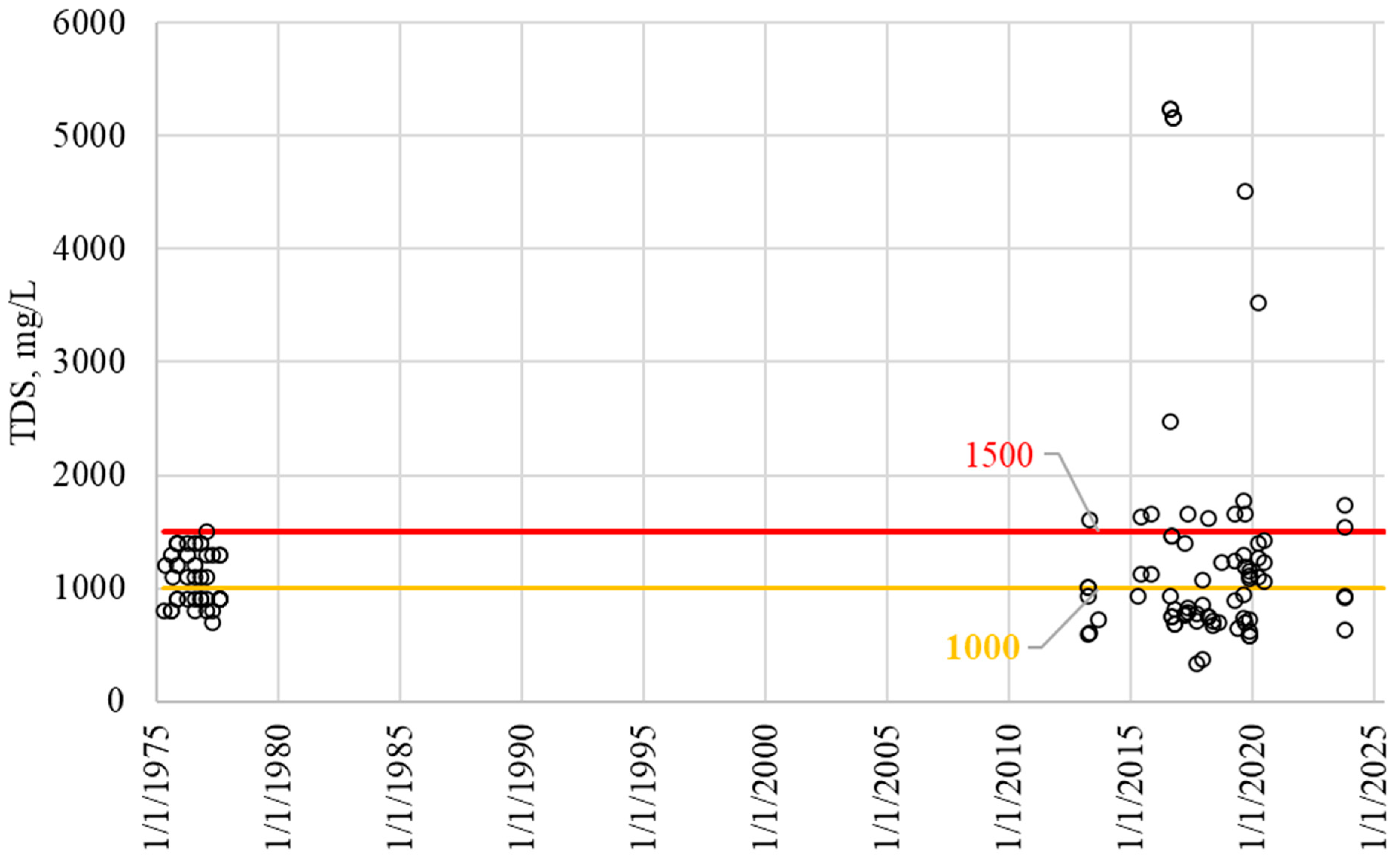


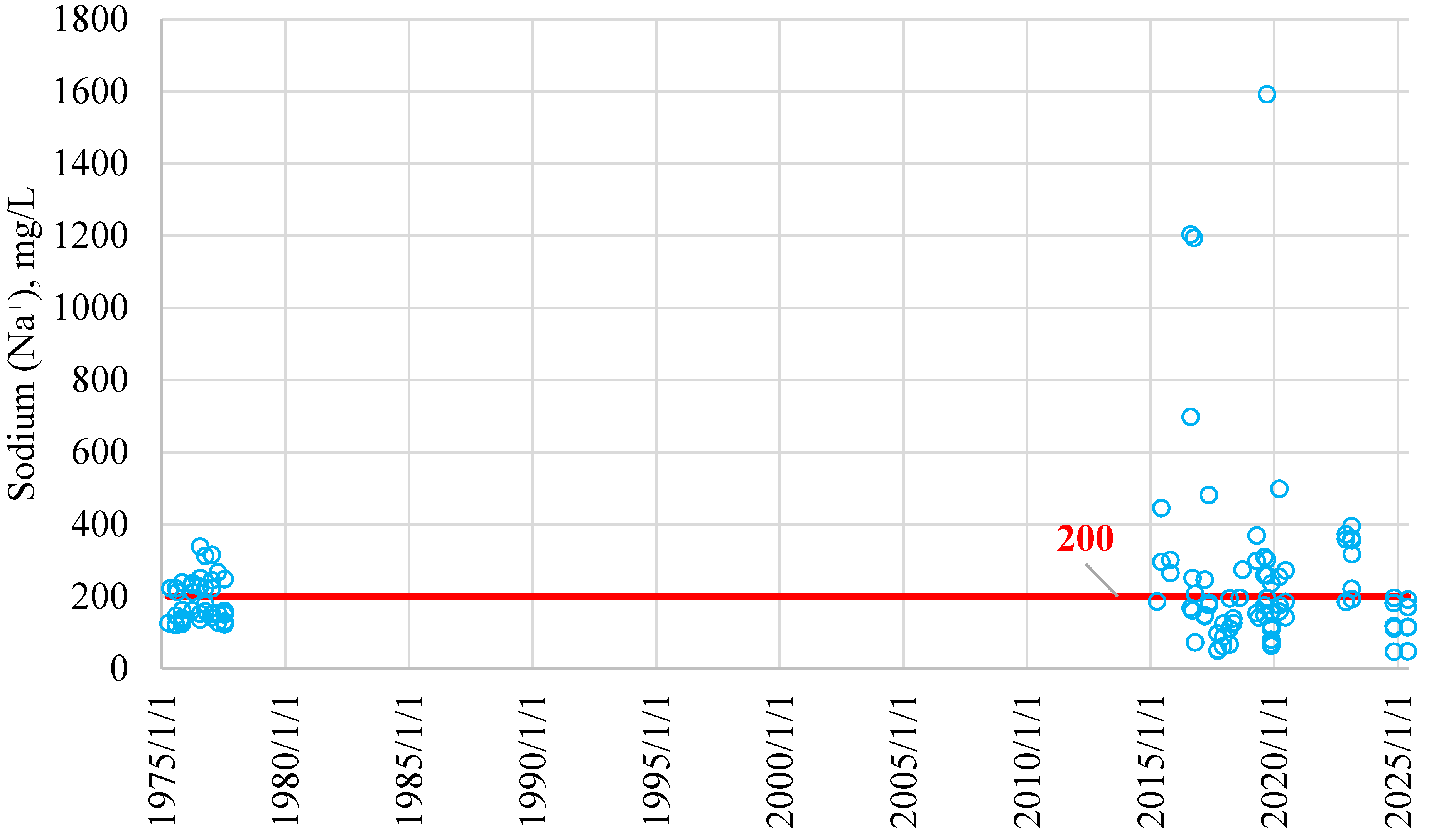

References
- UNESCO. The United Nations World Water Development Report 2025: Mountains and Glaciers—Water Towers; United Nations Educational, Scientific and Cultural Organization: Paris, France, 2025; Available online: https://www.unwater.org/publications/un-world-water-development-report-2025 (accessed on 3 September 2025).
- Rao, P.V.; Subrahmanyam, M.B.; Raju, B.A. Groundwater exploration in hard rock terrains of East Godavari district, Andhra Pradesh, India using AHP and WIO analyses together with geoelectrical surveys. AIMS Geosci. 2021, 7, 244. [Google Scholar] [CrossRef]
- Chen, J.; Xue, L. Is ground-water in arid inland drainage basins a resource for sustainable development? J. Arid Environ. 2003, 55, 389. [Google Scholar] [CrossRef]
- Onglassynov, Z.A.; Shagarova, L.V.; Muratova, M.M. Satellite data spectral analysis under critical hydrogeological amelioratory conditions of Golodnostepsky irrigation lands. E3S Web Conf. 2023, 407, 02005. [Google Scholar] [CrossRef]
- Abdekareem, M.; Al-Arifi, N.; Abdalla, F.; Mansour, A.; El-Baz, F. Fusion of Remote Sensing Data Using GIS-Based AHP-Weighted Overlay Techniques for Groundwater Sustainability in Arid Regions. Sustainability 2022, 14, 7871. [Google Scholar] [CrossRef]
- Agarwal, R.; Garg, P. Remote Sensing and GIS Based Groundwater Potential & Recharge Zones Mapping Using Multi-Criteria Decision Making Technique. Water Resour. Manag. 2015, 30, 243–260. [Google Scholar] [CrossRef]
- Srivastava, P.; Bhattacharya, A. Groundwater assessment through an integrated approach using remote sensing, GIS and resistivity techniques: A case study from a hard rock terrain. Int. J. Remote Sens. 2006, 27, 4599–4620. [Google Scholar] [CrossRef]
- Waters, P.; Greenbaum, D.; Smart, P.L.; Osmaston, H. Applications of remote sensing to groundwater hydrology. Remote Sens. Rev. 1990, 4, 223. [Google Scholar] [CrossRef]
- Ostanin, O.; Dyakova, G.; Lebedeva, A.S. The Application of GIS Technologies and Remote Sensing Data to Determine the Morphometric Features of the River Basin: The Case of the Upper Part of the Charysh River. IOP Conf. Ser. Earth Environ. Sci. 2021, 670, 12061. [Google Scholar] [CrossRef]
- Kumari, L. Delineation of Potential Groundwater Zone Using RS and GIS: A Review. Int. J. Curr. Microbiol. Appl. Sci. 2018, 7, 196. [Google Scholar] [CrossRef]
- Niraula, R.R.; Sharma, S.; Pokharel, B.K.; Paudel, U. Spatial prediction of spring locations in data poor region of Central Himalayas. Hydrol. Res. 2020, 52, 492. [Google Scholar] [CrossRef]
- Khan, U.; Faheem, H.; Jiang, Z.; Wajid, M.; Younas, M.; Zhang, B. Integrating a GIS-Based Multi-Influence Factors Model with Hydro-Geophysical Exploration for Groundwater Potential and Hydrogeological Assessment: A Case Study in the Karak Watershed, Northern Pakistan. Water 2021, 13, 1255. [Google Scholar] [CrossRef]
- Chalkias, C.; Stathopoulos, N.; Kalogeropoulos, K.; Karymbalis, E. Applied Hydrological Modeling with the Use of Geoinformatics: Theory and Practice; InTech eBooks: London, UK, 2016. [Google Scholar] [CrossRef][Green Version]
- Mondal, S. Remote Sensing and GIS Based Ground Water Potential Mapping of Kangshabati Irrigation Command Area, West Bengal. J. Geogr. Nat. Disasters 2012, 1, 1–8. [Google Scholar] [CrossRef]
- Alshehri, F.; Abd El-Hamid, H.T.; Mohamed, A. Mapping Coastal Groundwater Potential Zones Using Remote Sensing-Based AHP Model in Al Qunfudhah Region along Red Sea, Saudi Arabia. Heliyon 2024, 10, e28186. [Google Scholar] [CrossRef]
- Masoud, A.M.; Koike, K.; Ghoneim, E.; Hassan, A.M. Efficiency of Geospatial Technology and MCDA for Groundwater Potential Mapping in Arid Regions: A Case Study from Egypt. Water 2022, 14, 882. [Google Scholar] [CrossRef]
- Ashraf, M.U.; Mushtaq, M.; Awan, A.; Iqbal, S.; Hussain, M.; Riaz, M.T.; Gul, S. Ascertainment of the Most Suitable Water Harvesting Sites in an Arid Region of Pakistan Using PROMETHEE-II and AHP within a GIS Environment. Water Pract. Technol. 2024, 19, 796–811. [Google Scholar] [CrossRef]
- Rawat, A.; Bera, A.; Prusty, B.K.; Sahoo, S. Scaling Up Indigenous Rainwater Harvesting for Sustainable Agriculture in Rajasthan Using GIS-Based AHP. Water 2023, 15, 2042. [Google Scholar] [CrossRef]
- Halder, S.; Dutta, S.; Chattopadhyay, P.; Mondal, S.; Sharma, A.; Singh, R. Ground–Surface Water Assessment in a Semi-Arid Basin: Integrating SWAT and VIKOR for Sustainable Land and Water Management. Water 2025, 17, 880. [Google Scholar] [CrossRef]
- Nathawat, R.; Singh, S.; Pandey, A.; Sharma, K.; Sharma, P. Urban Green Infrastructure Planning in Semi-Arid Cities Using GIS-Based MCDA: A Case from Jaipur, India. Sustainability 2025, 17, 2420. [Google Scholar] [CrossRef]
- Valjarević, A.; Šiljeg, A.; Šiljeg, S.; Vujović, F.; Sahay, A. GIS-Based Water Stress Analysis in North African Drylands. J. Arid Environ. 2025, 230, 105427. [Google Scholar] [CrossRef]
- Dyer, J.S. Remarks on the Analytic Hierarchy Process. Manag. Sci. 1990, 36, 249–258. [Google Scholar] [CrossRef]
- Sallwey, J.; Bonilla Valverde, J.P.; Vásquez López, F.; Junghanns, R.; Stefan, C. Suitability Maps for Managed Aquifer Recharge: A Review of Multi-Criteria Decision Analysis Studies. Environ. Rev. 2019, 27, 138–150. [Google Scholar] [CrossRef]
- Li, T.; Bian, J.; Ruan, D.; Xu, L.; Zhang, S. Groundwater Health Risk Assessment and Its Temporal and Spatial Evolution Based on Trapezoidal Fuzzy Number–Monte Carlo Stochastic Simulation: A Case Study in Western Jilin Province. Ecotoxicol. Environ. Saf. 2024, 282, 116736. [Google Scholar] [CrossRef]
- Forootan, E. The Integrated Fuzzy AHP and Fuzzy Logic Techniques for Mapping and Prioritizing Groundwater Potential Zone Based on Water Quality. Environ. Monit. Assess. 2025, 197, 698. [Google Scholar] [CrossRef]
- Gupta, M.; Srivastava, P.K. Integrating GIS and remote sensing for identification of groundwater potential zones in the hilly terrain of Pavagarh, Gujarat, India. Water Int. 2010, 35, 233. [Google Scholar] [CrossRef]
- Kumar, V.; Mondal, N.; Mondal, N.; Ahmed, S. Identification of Groundwater Potential Zones Using RS, GIS and AHP Techniques: A Case Study in a Part of Deccan Volcanic Province (DVP), Maharashtra, India. J. Indian Soc. Remote Sens. 2020, 48, 497–511. [Google Scholar] [CrossRef]
- Arulbalaji, P.; Padmalal, D.; Sreelash, K. GIS and AHP Techniques Based Delineation of Groundwater Potential Zones: A case study from Southern Western Ghats, India. Sci. Rep. 2019, 9, 2082. [Google Scholar] [CrossRef]
- Ni, B.; Wang, D.; Deng, Z.; Xu, H.; Wang, D.; Jiang, X. Review on the Groundwater Potential Evaluation Based on Remote Sensing Technology. IOP Conf. Ser. Mater. Sci. Eng. 2018, 394, 52038. [Google Scholar] [CrossRef]
- Indhulekha, K.; Mondal, K.C.; Jhariya, D.C. Groundwater prospect mapping using remote sensing, GIS and resistivity survey techniques in Chhokra Nala Raipur district, Chhattisgarh, India. J. Water Supply Res. Technol. AQUA 2019, 68, 595. [Google Scholar] [CrossRef]
- Weather and Climate Reference Portal. Available online: http://www.pogodaiklimat.ru/history.php?id=kz (accessed on 15 September 2025).
- Saaty, T.L. The Analytic Hierarchy Process: Planning, Priority Setting, Resource Allocation; McGraw-Hill: New York, NY, USA, 1980; p. 287. [Google Scholar]
- Saaty, T.L. How to Make a Decision: The Analytic Hierarchy Process. Aestimum 1994, 24, 19–43. [Google Scholar] [CrossRef]
- Goepel, K.D. AHP Excel Template Version 2022.07.08. Business Performance Management Singapore. Available online: https://bpmsg.com/new-ahp-excel-template-with-multiple-inputs/ (accessed on 15 September 2025).
- Saaty, T.L. The Analytic Hierarchy Process: What is it and how it is used. Math. Model. 1987, 9, 161–176. [Google Scholar] [CrossRef]
- Kasymbekov, D.A. The Formation of Groundwater in the Chu-Ili Mountain-Fold Region (Southeastern Part and Its Surroundings) and Prospects for Its Use. Ph.D. Thesis, Kazakh National Technical University, Almaty, Kazakhstan, 1990. [Google Scholar]
- National Standard ST RK GOST R 51232., 2003. Drinking Water General Requirements for the Organization and Methods of Quality Control. In Proceedings of the Committee for Standardization, Metrology and Certification, Astana, Kazakhstan, 29 September 2003; Available online: https://waterservice.kz/downloads/rd/gst7.pdf?ysclid=ld3fpwacho899490449 (accessed on 15 September 2025). (In Kazakh and Russian Languages).
- Soller, D.R. U.S. Geological Survey Open-File Report 2012–1171. Digital Mapping Techniques ‘10—Workshop Proceedings, 2012; 178p. Available online: https://pubs.usgs.gov/of/2012/1171/pdf/usgs_of2012-1171.pdf (accessed on 15 September 2025).
- Monir, M.M.; Sarker, S.C.; Islam, A.R.M.T. A critical review on groundwater level depletion monitoring based on GIS and data-driven models: Global perspectives and future challenges. HydroResearch 2024, 7, 285. [Google Scholar] [CrossRef]
- Jagadeesh, B.R.; Veni, K.K. Flood Plain Modelling of Krishna Lower Basin Using Arcgis, Hec-Georas and Hec-Ras. IOP Conf. Ser. Mater. Sci. Eng. 2021, 1112, 12024. [Google Scholar] [CrossRef]
- Flora, F.M.I. A GIS-based on application of Monte Carlo and multi-criteria decision-making approach for site suitability analysis of solar-hydrogen production: Case of Cameroon. Heliyon 2025, 11, e41541. [Google Scholar] [CrossRef] [PubMed]
- Thongley, T.; Choki, T.; Choden, K. Groundwater Potential Mapping at Highly Populated Sub-districts of Thimphu District Using Fuzzy Analytic Hierarchy Process. Appl. Environ. Res. 2023, 45. [Google Scholar] [CrossRef]
- Shao, Z.; Huq, M.; Cai, B.; Altan, O.; Li, Y. Integrated remote sensing and GIS approach using Fuzzy-AHP to delineate and identify groundwater potential zones in semi-arid Shanxi Province, China. Environ. Model. Softw. 2020, 134, 104868. [Google Scholar] [CrossRef]
- Ågren, A.M.; Larson, J.; Paul, S.S.; Laudon, H.; Lidberg, W. Use of Multiple LiDAR-Derived Digital Terrain Indices and Machine Learning for High-Resolution National-Scale Soil Moisture Mapping of the Swedish Forest Landscape. Geoderma 2021, 404, 115280. [Google Scholar] [CrossRef]
- Xiong, H.; Yang, S.; Tan, J.; Wang, Y.; Guo, X.; Ma, X. Effects of DEM Resolution and Application of Solely DEM-Derived Indicators on Groundwater Potential Mapping in the Mountainous Area. J. Hydrol. 2024, 636, 131349. [Google Scholar] [CrossRef]
- Talukdar, S.; Mallick, J.; Sarkar, S.K.; Roy, S.K.; Islam, A.R.M.T.; Praveen, B.; Naikoo, M.W.; Rahman, A.; Sobnam, M. Novel Hybrid Models to Enhance the Efficiency of Groundwater Potentiality Model. Appl. Water Sci. 2022, 12, 62. [Google Scholar] [CrossRef]
- Nguyen, P.T.; Ha, D.H.; Jaafari, A.; Nguyen, H.D.; Van Phong, T.; Al-Ansari, N.; Prakash, I.; Le, H.V.; Pham, B.T. Groundwater Potential Mapping Combining Artificial Neural Network and Real AdaBoost Ensemble Technique: The DakNong Province Case-Study, Vietnam. Int. J. Environ. Res. Public Health 2020, 17, 2473. [Google Scholar] [CrossRef]
- Arabameri, A.; Roy, J.; Saha, S.; Blaschke, T.; Ghorbanzadeh, O.; Tien Bui, D. Application of Probabilistic and Machine Learning Models for Groundwater Potentiality Mapping in Damghan Sedimentary Plain, Iran. Remote Sens. 2019, 11, 3015. [Google Scholar] [CrossRef]
- Madani, A.; Niyazi, B. Groundwater Potential Mapping Using Remote Sensing and Random Forest Machine Learning Model: A Case Study from Lower Part of Wadi Yalamlam, Western Saudi Arabia. Sustainability 2023, 15, 2772. [Google Scholar] [CrossRef]
- ISO 17294-2; Water Quality—Application of Inductively Coupled Plasma Mass Spectrometry (ICP-MS)—Part 2: Determination of 62 Elements. ISO: Geneva, Switzerland, 2003. Available online: https://cdn.standards.iteh.ai/samples/36127/5395f5b265b64455bb9890d9d161cf95/ISO-17294-2-2003.pdf (accessed on 15 June 2025).
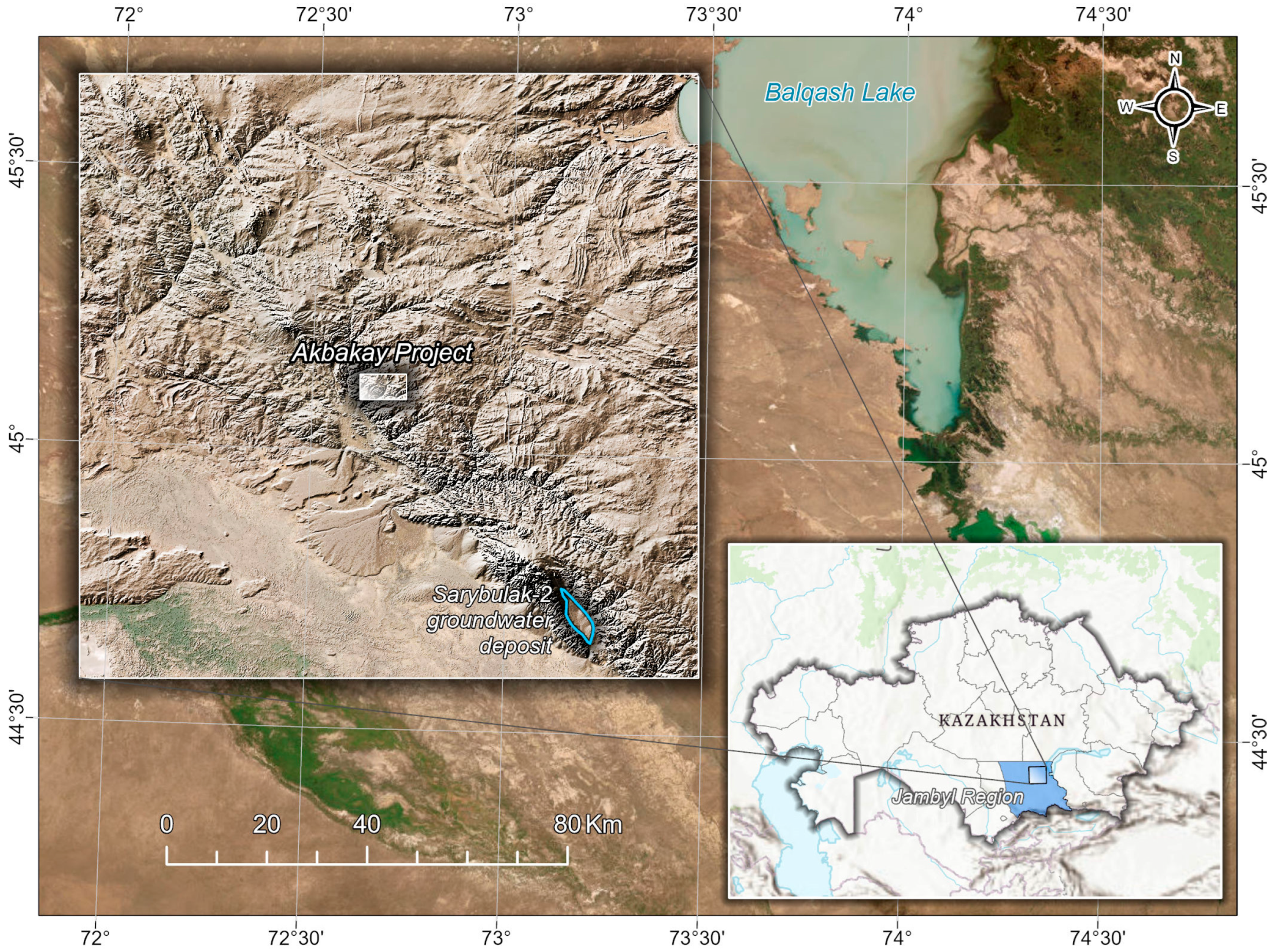
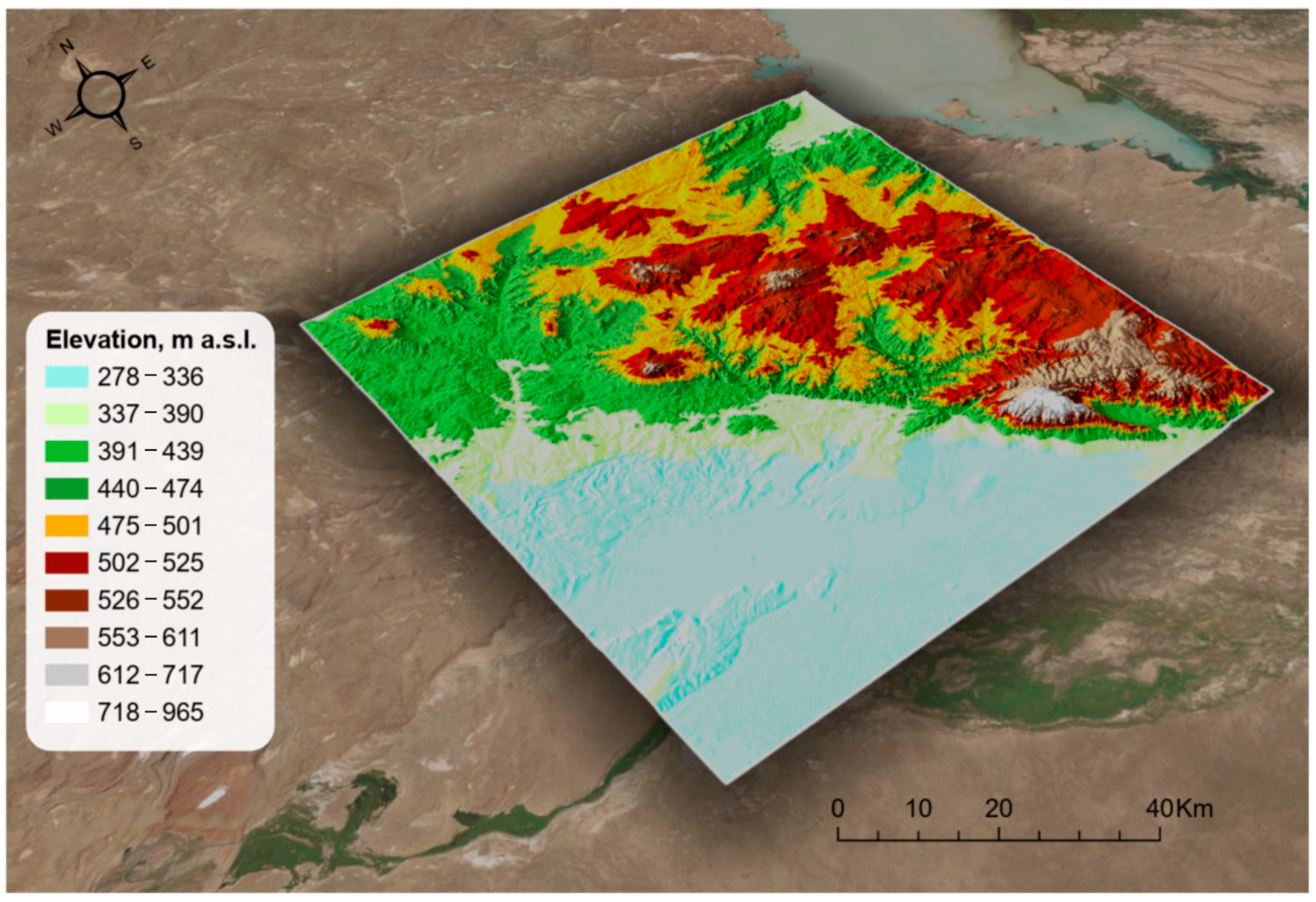

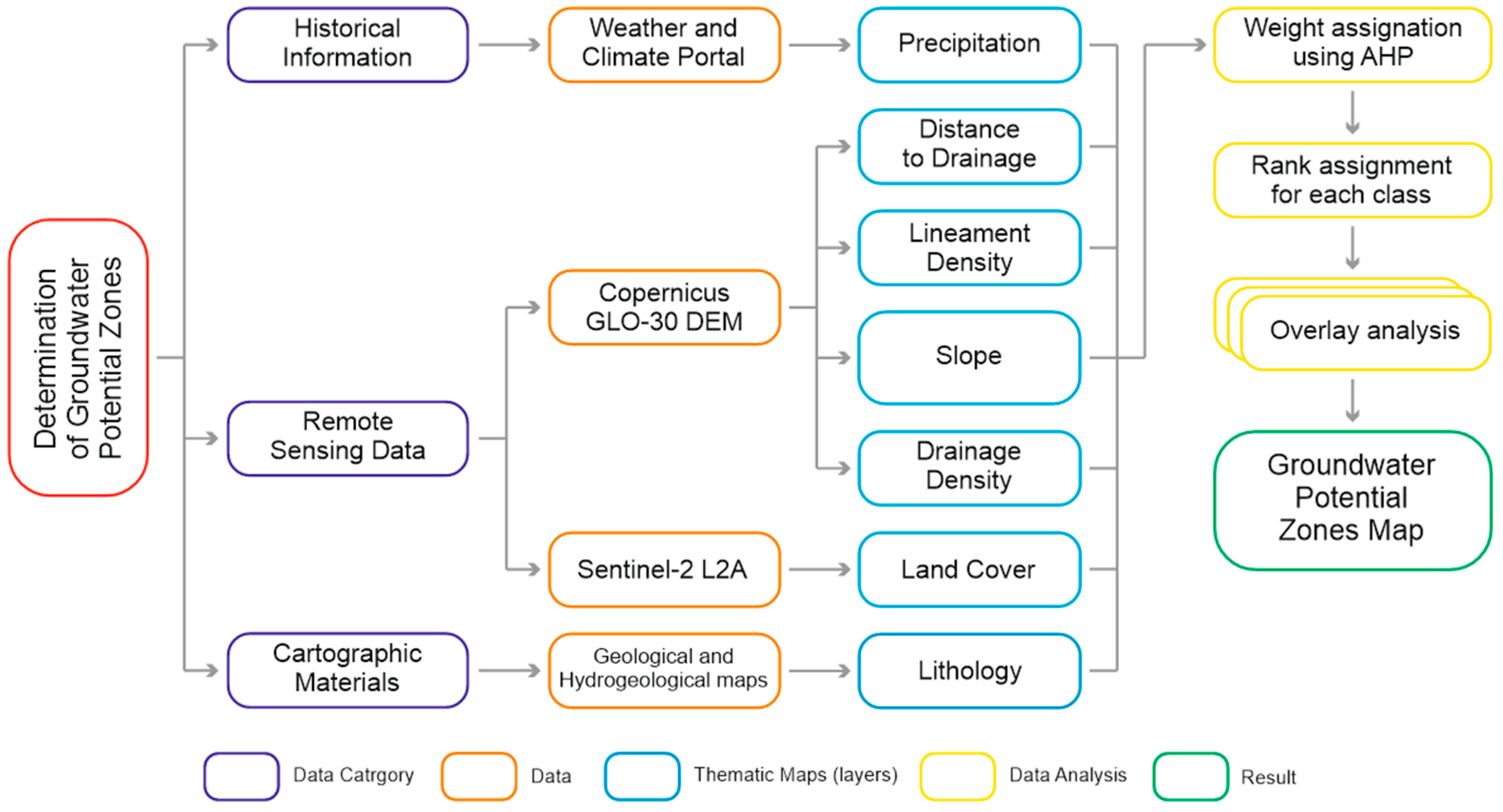
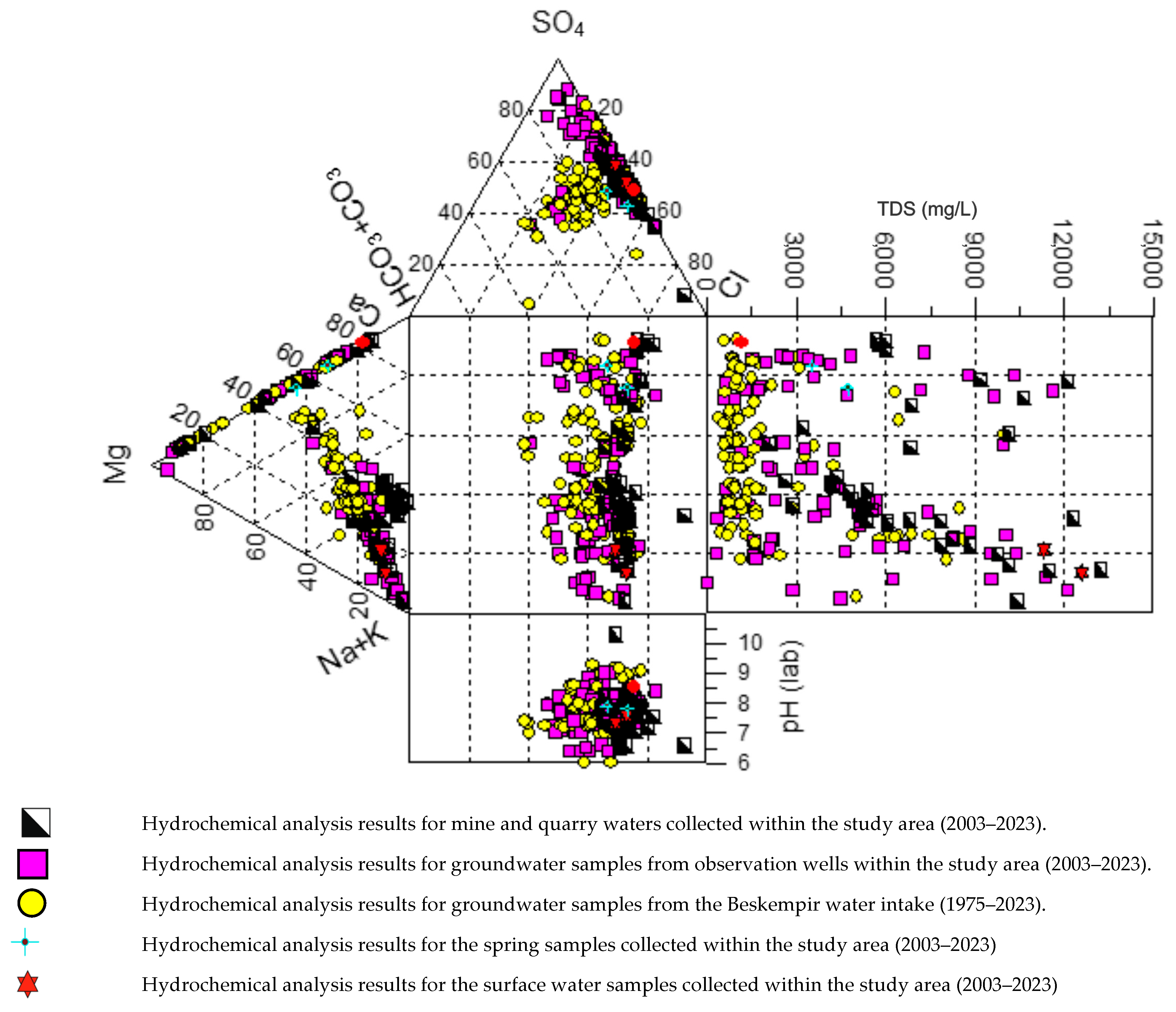
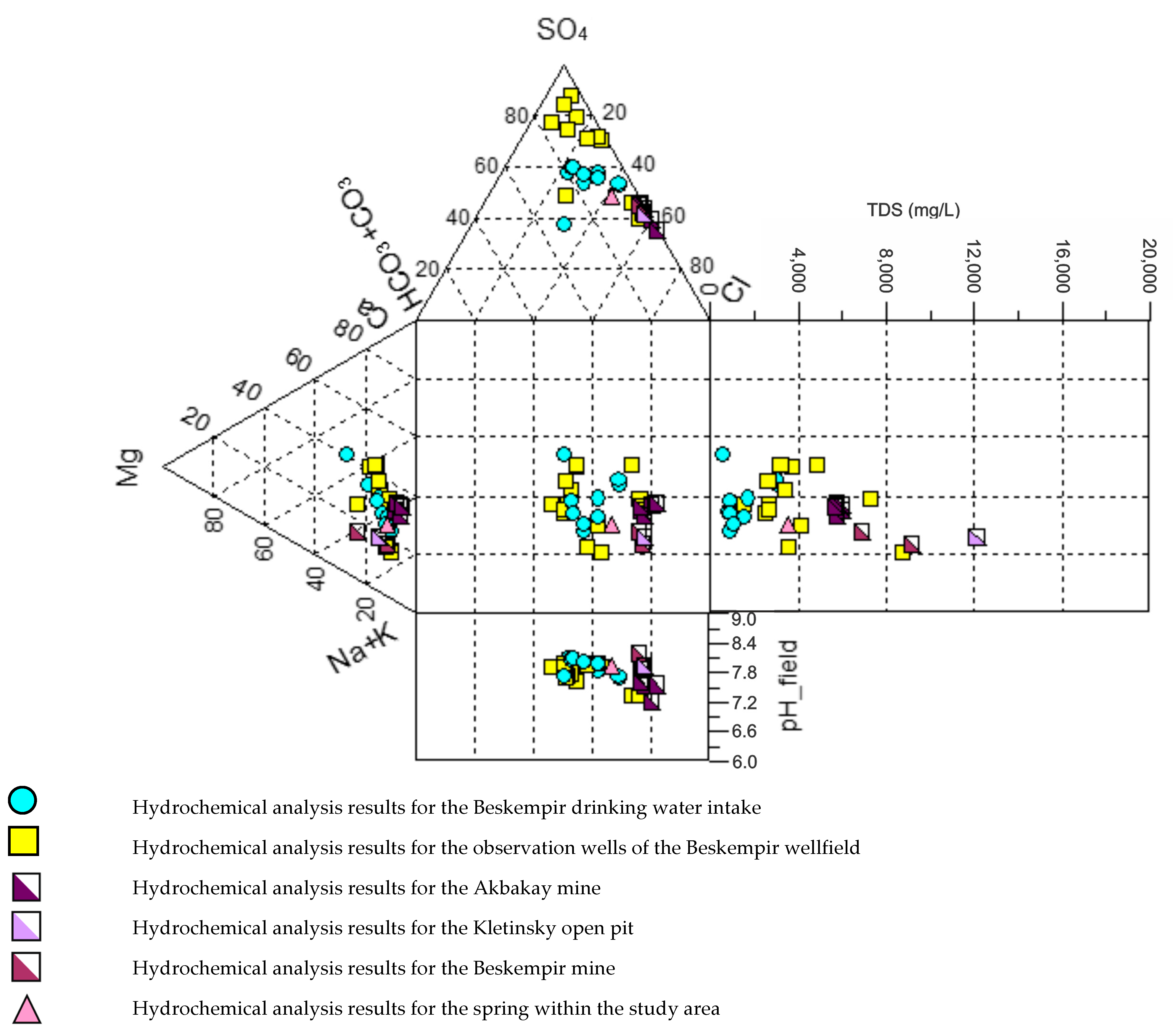

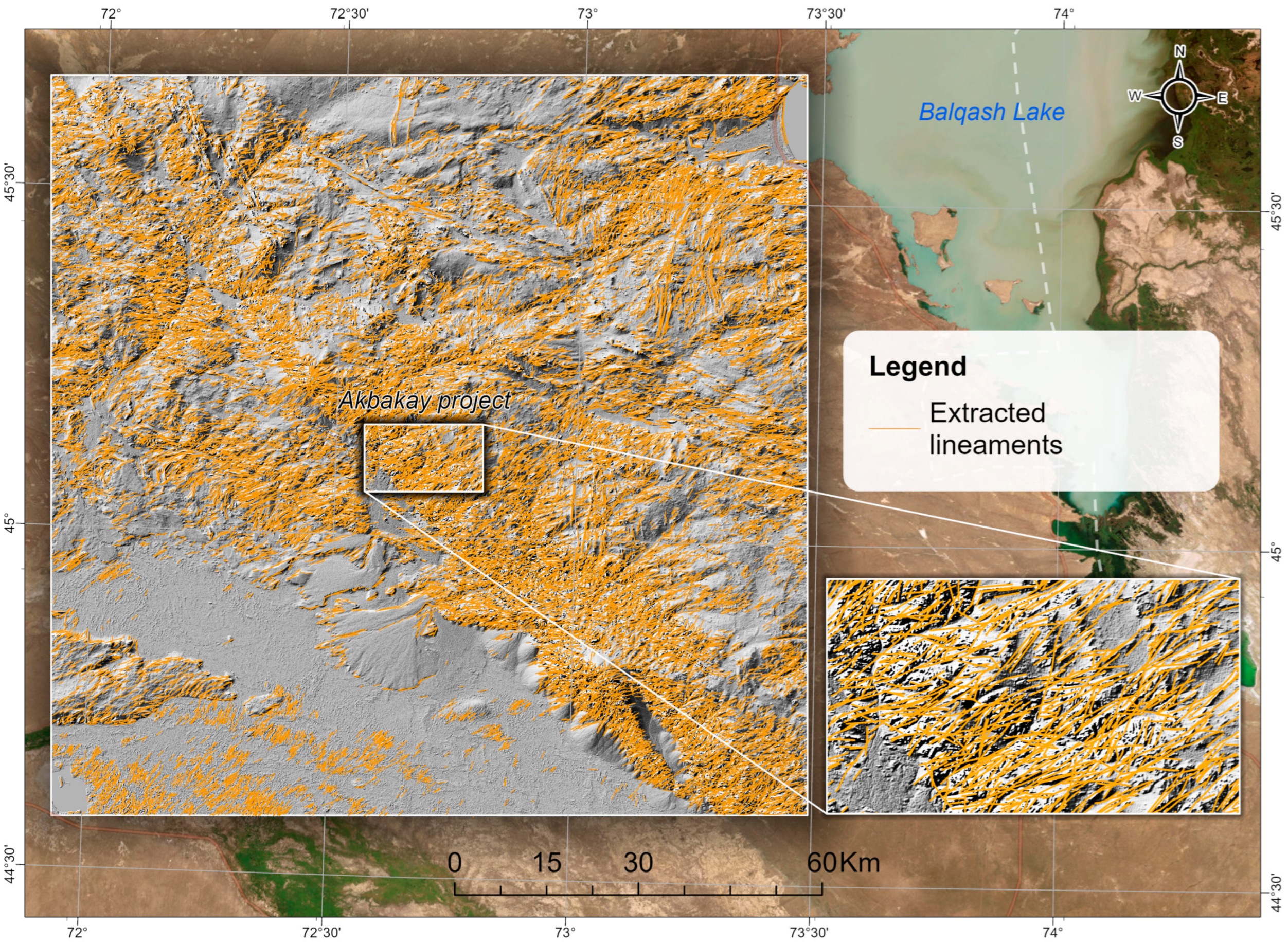

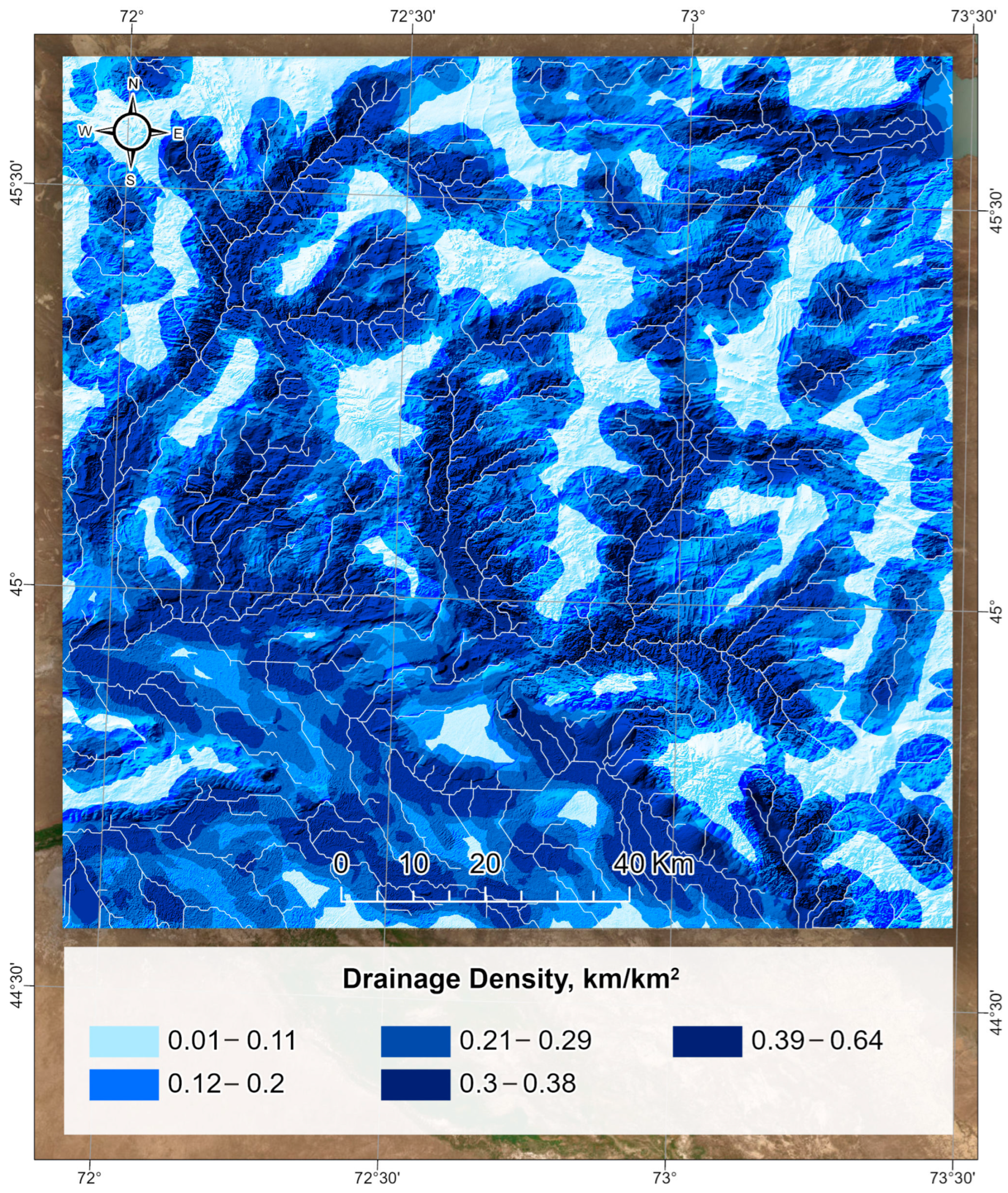
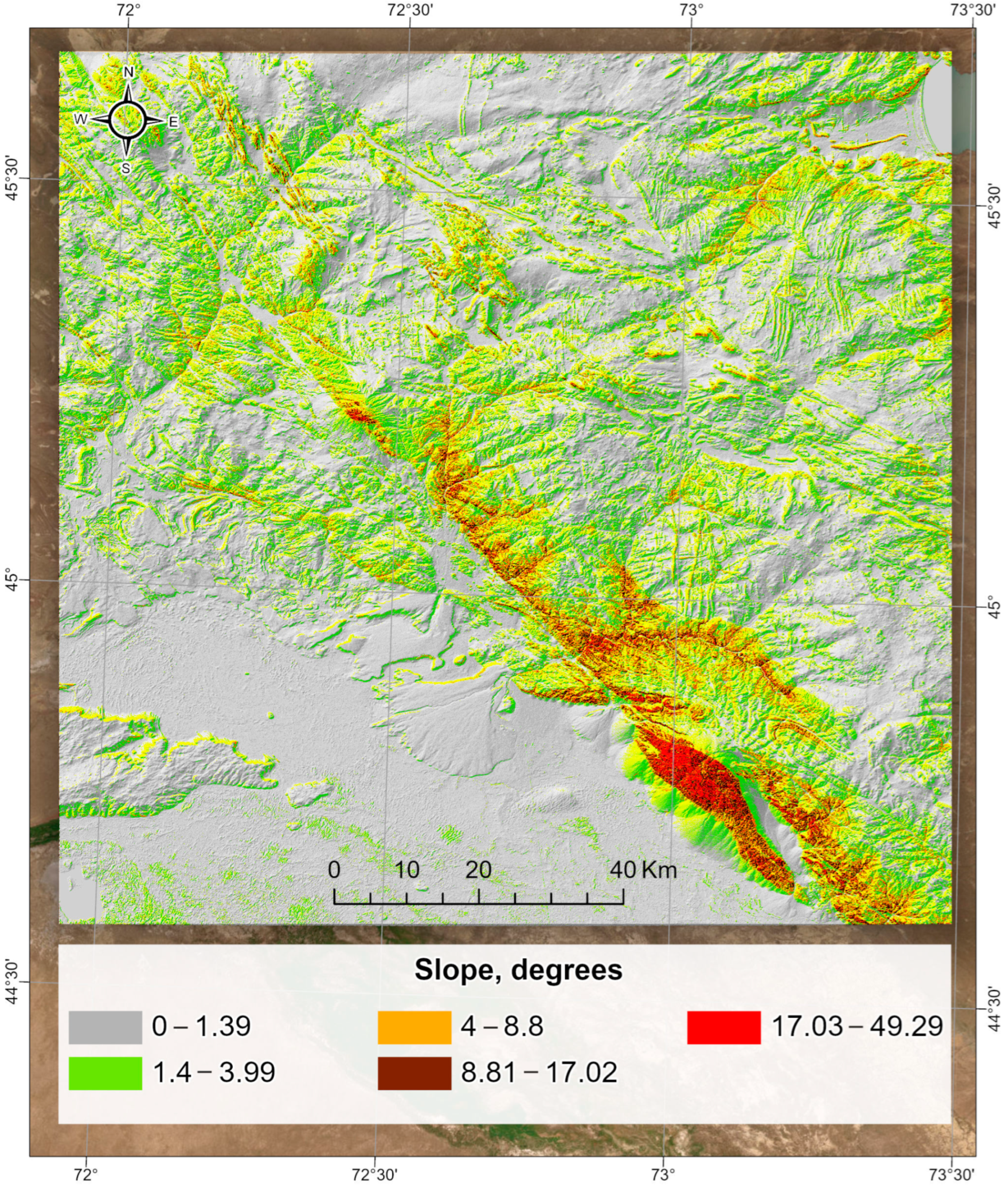
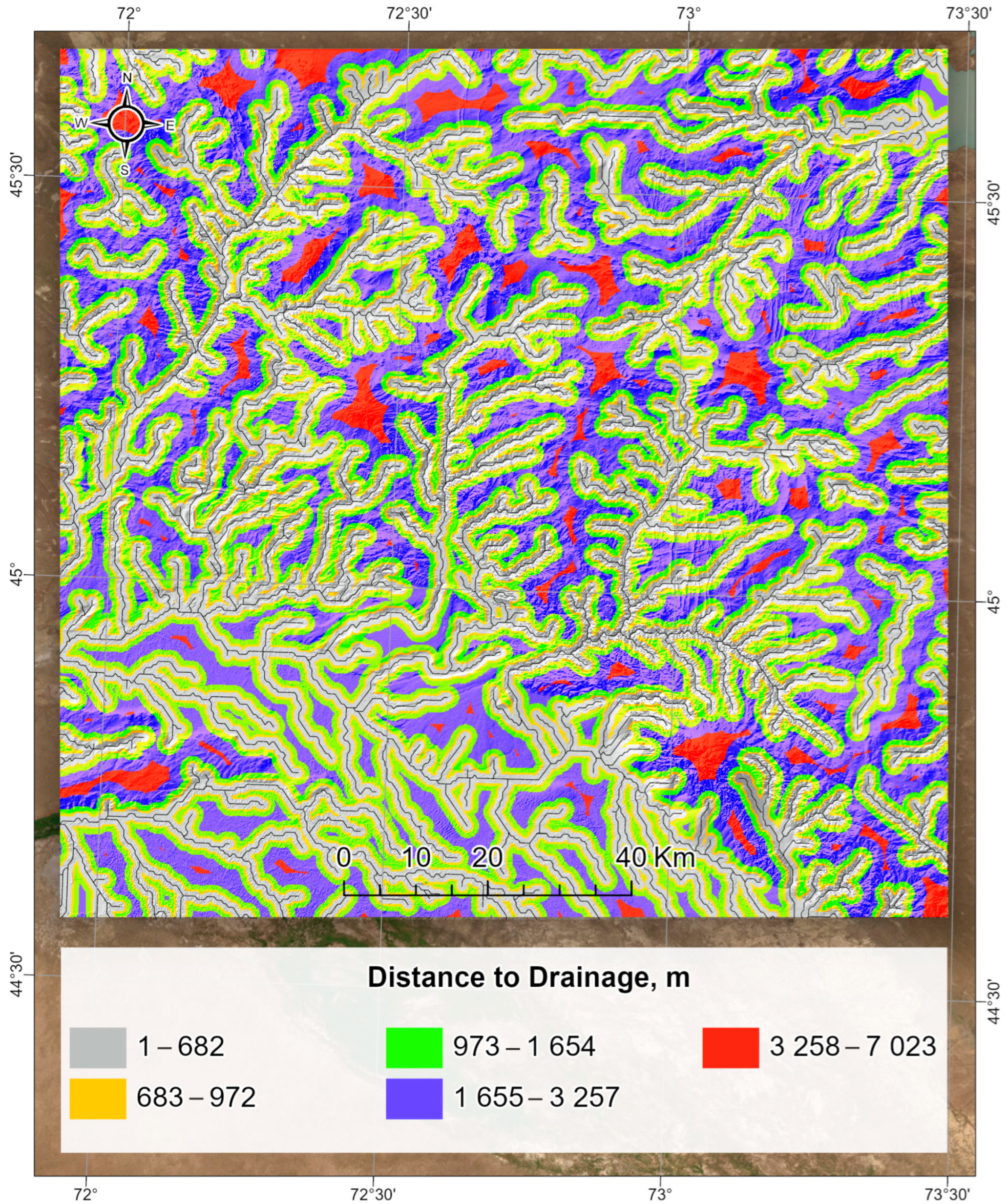
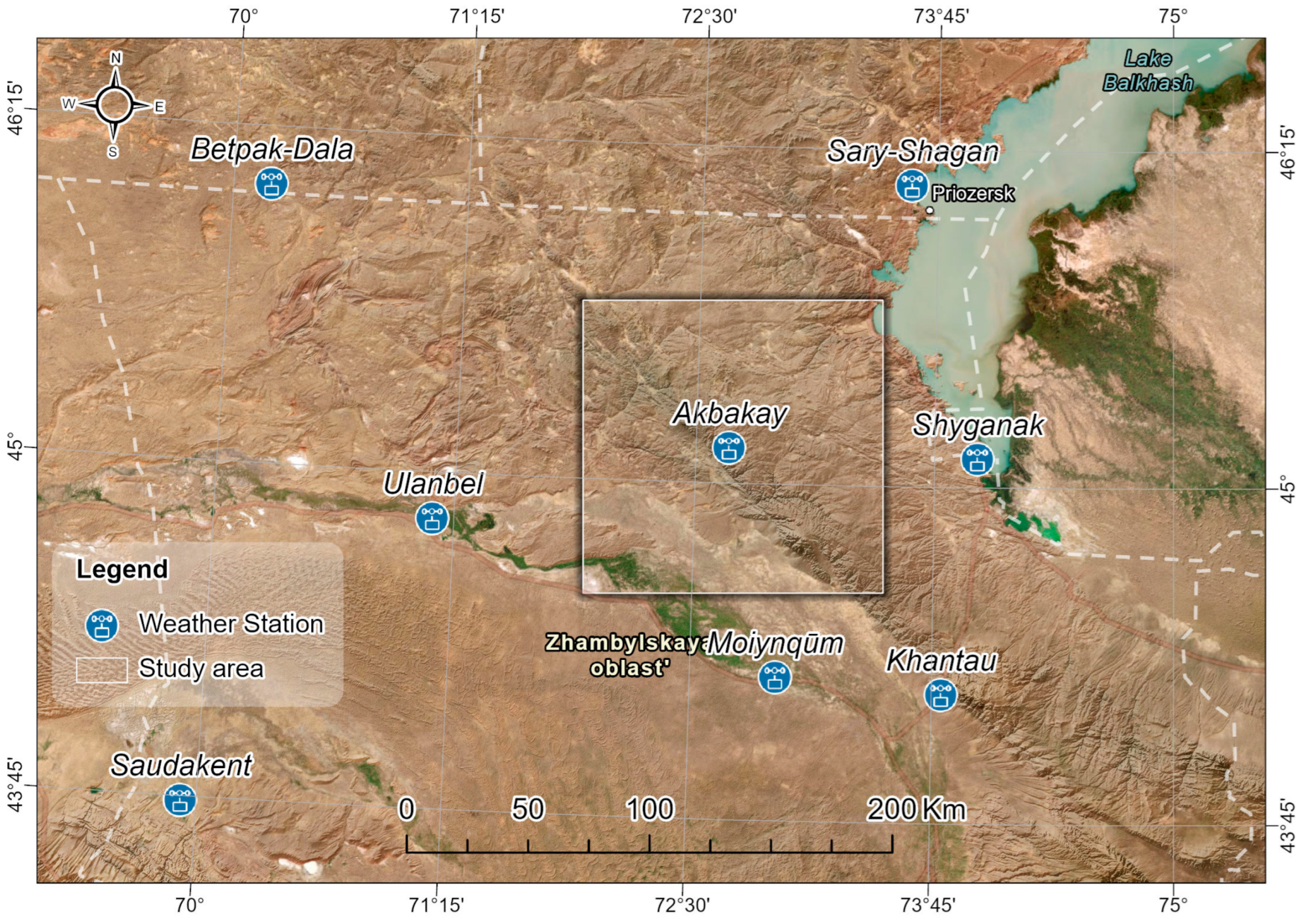
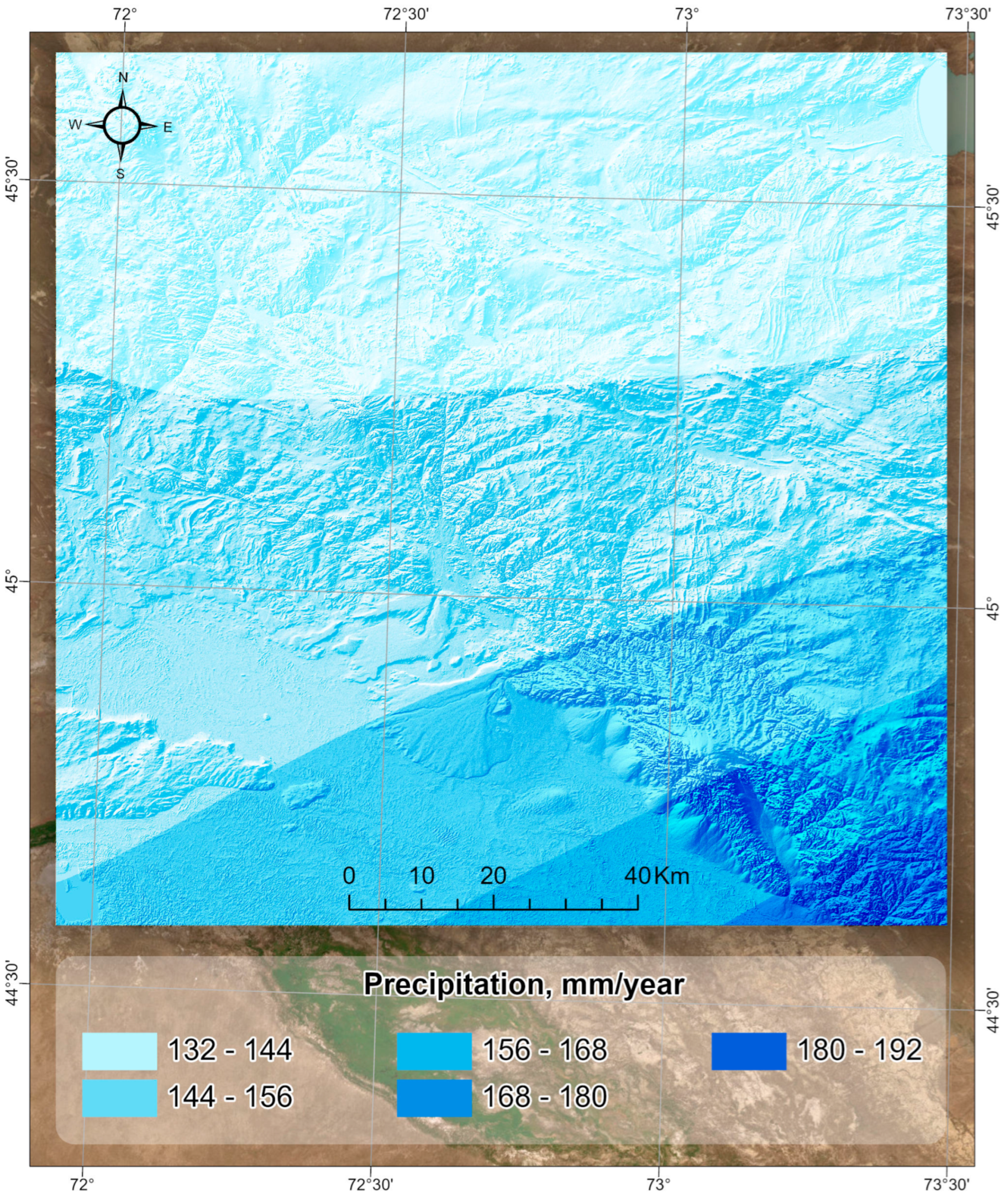
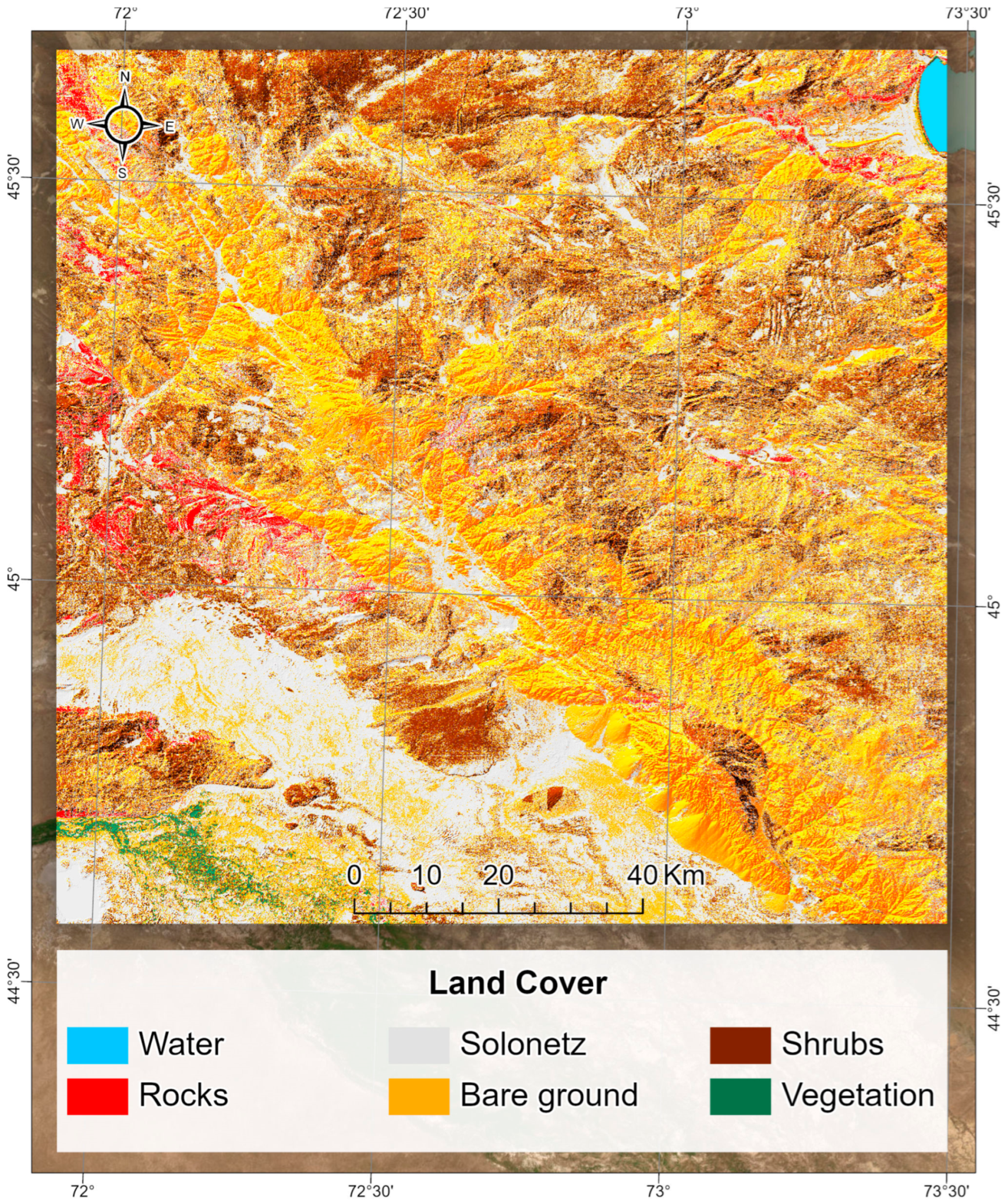
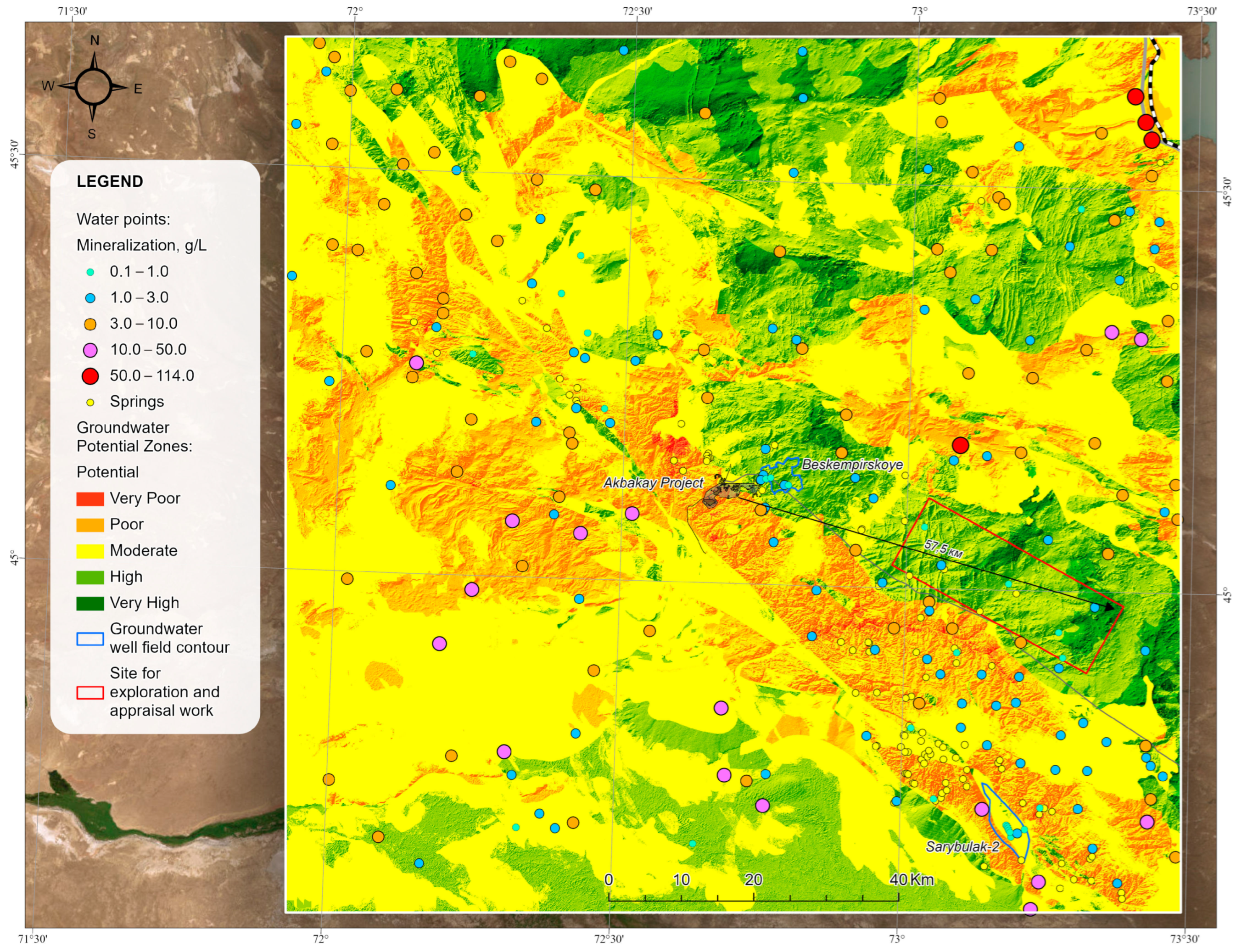
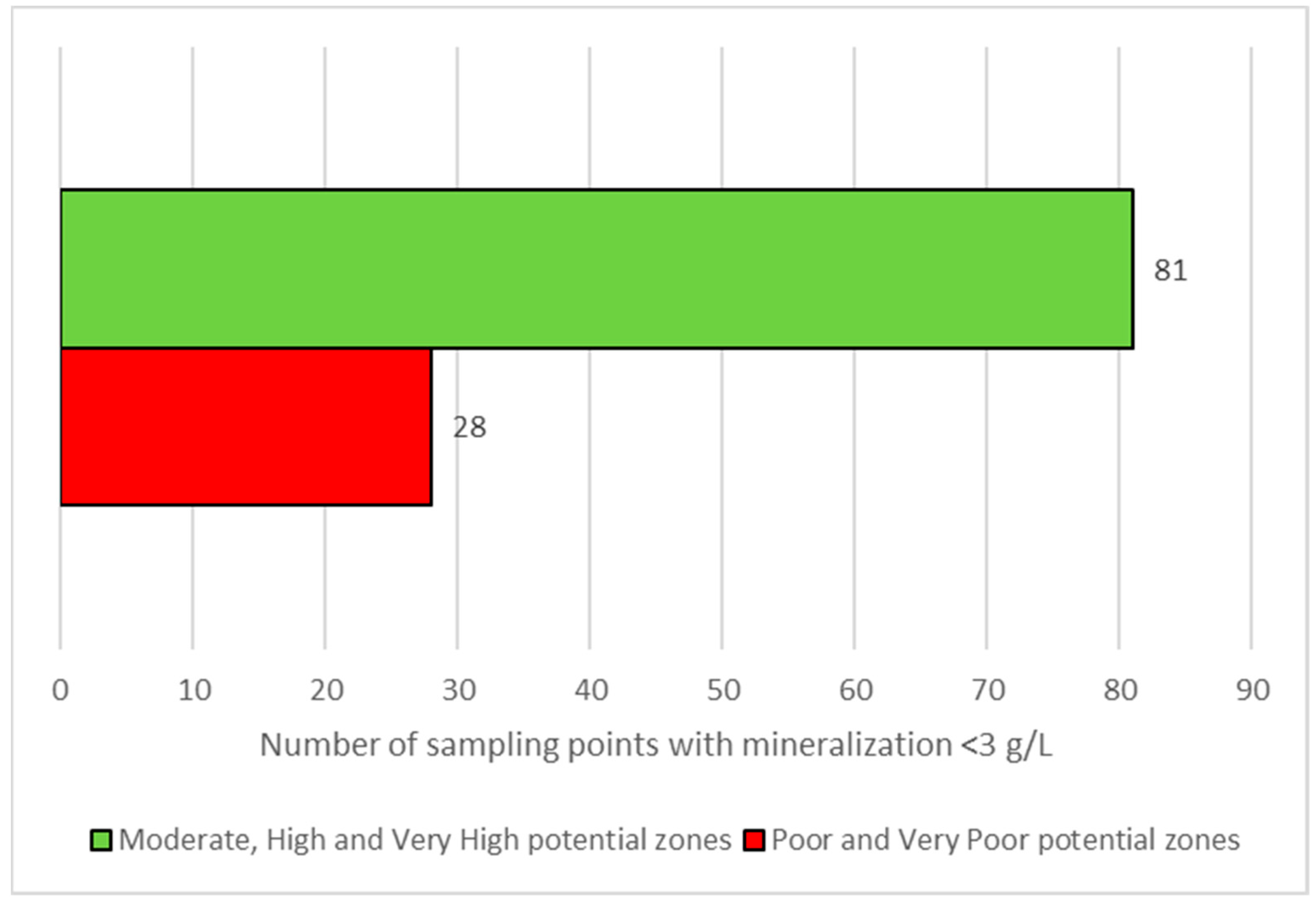
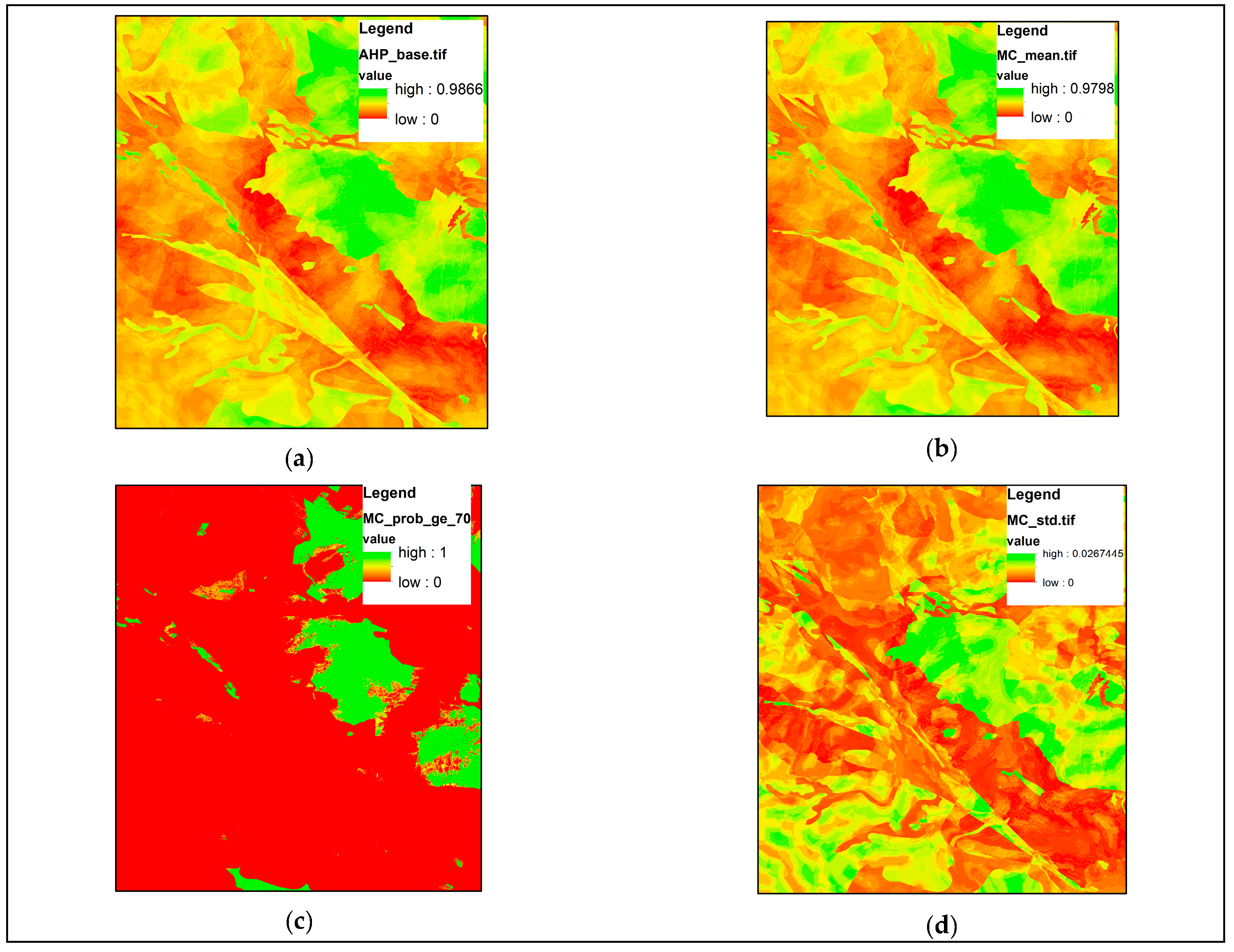
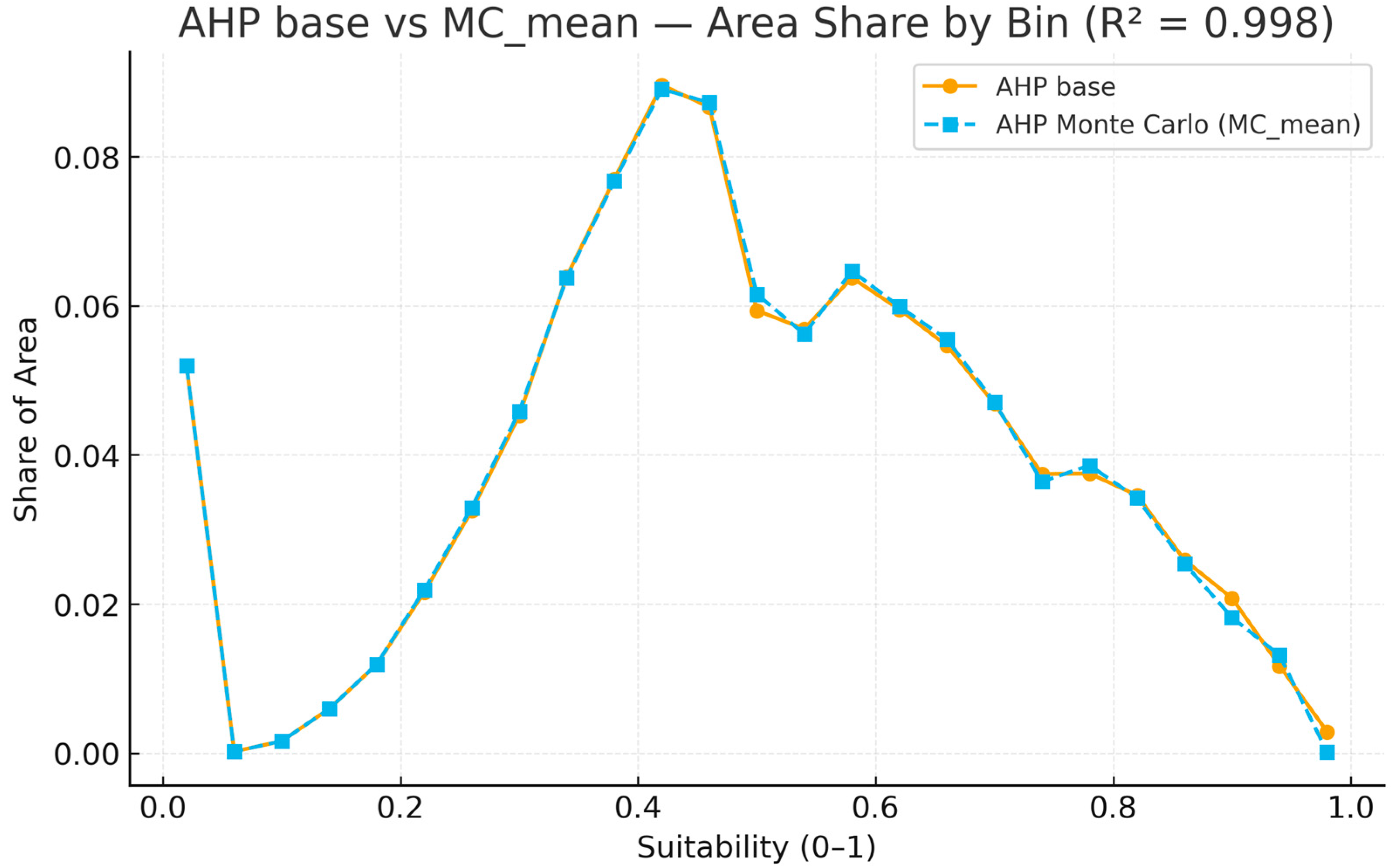
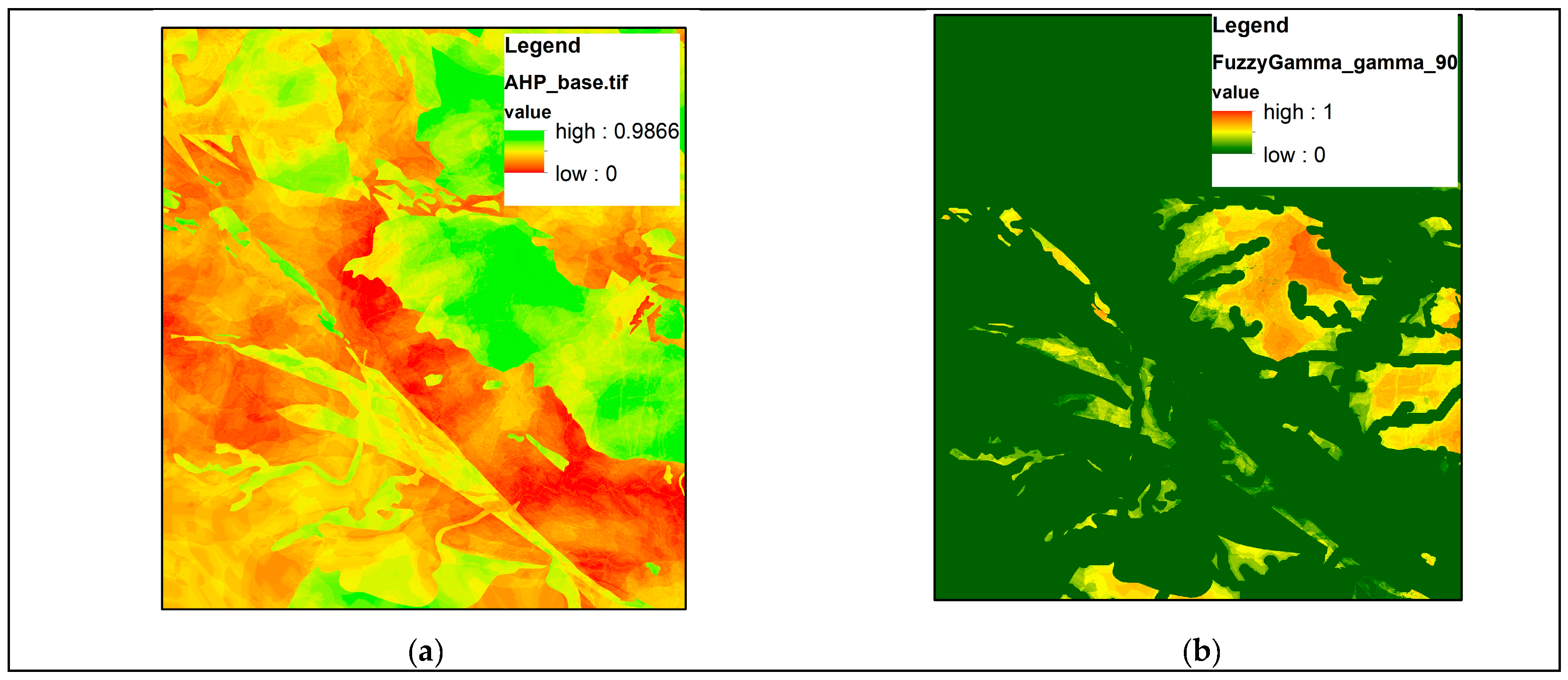
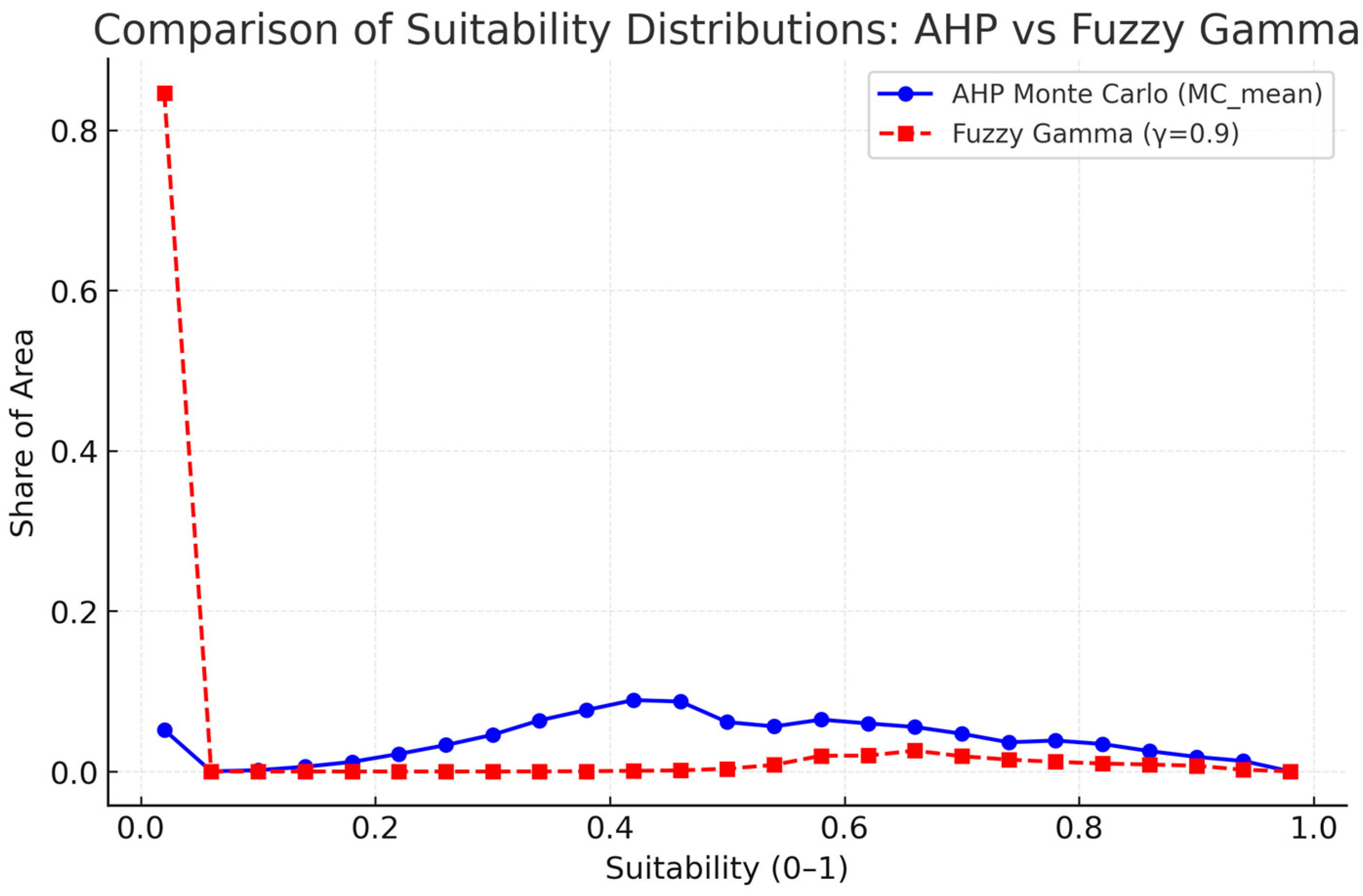
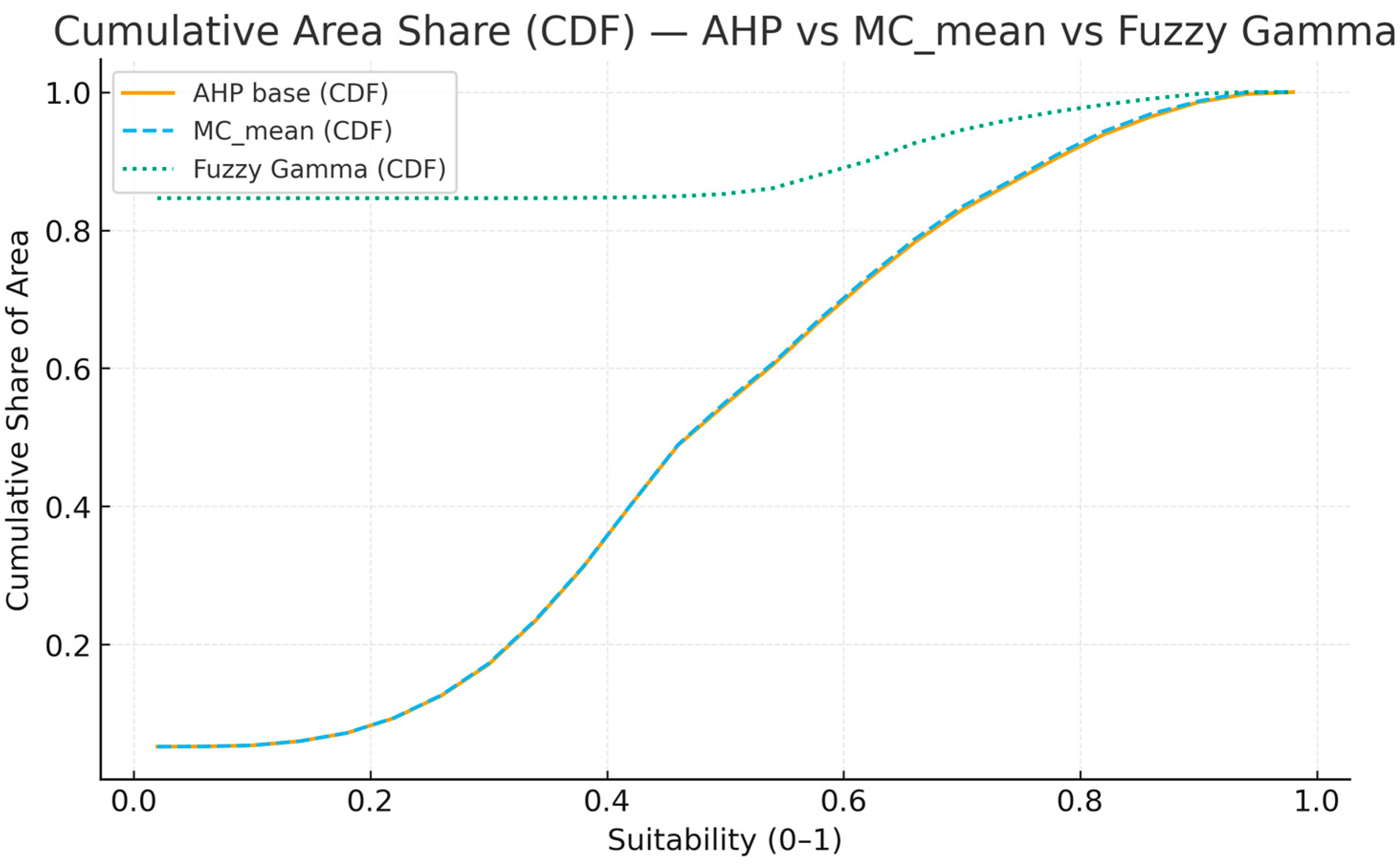
| Relative Importance Intensity in Points | Definition | Explanation |
|---|---|---|
| 1 | Equal importance of the criteria | The importance of objects (factors) is equal |
| 3 | Moderate superiority of one over the other | Experience and judgement give slight superiority to one object (factor) over the other |
| 5 | Substantial or strong superiority | Evidence suggests a marked superiority of one object (factor) over the other |
| 7 | Very strong superiority | The superiority of the object (factor) is obvious |
| 9 | Absolute superiority | The obviousness of superiority of the object (factor) is confirmed by all available signs |
| 2, 4, 6, 8 | Intermediate judgements between two neighbouring judgements | Used in compromise cases |
| 1/3, 1/5, 1/7 | Inverse values show that the first criterion is inferior in importance to the second criterion |
| Thematic Maps | Lithology | Lineament Density | Erosion Network Density | Daylight Surface Slope | Distance-to-Erosion | Precipitation | Land Cover | Weight |
|---|---|---|---|---|---|---|---|---|
| Lithology | 1 | 3 | 3 | 3 | 5 | 5 | 7 | 37.32 |
| Lineament Density | 1/3 | 1 | 1 | 3 | 5 | 5 | 7 | 22.06 |
| Drainage Density | 1/3 | 1/3 | 1 | 1 | 3 | 3 | 5 | 16.03 |
| Slope | 1/5 | 1/3 | 1/3 | 1 | 3 | 3 | 5 | 11.14 |
| Distance to drainage | 1/5 | 1/3 | 1/3 | 1/3 | 1 | 1 | 3 | 8.09 |
| Precipitation | 1/7 | 1/5 | 1/5 | 1/5 | 1/5 | 1 | 3 | 3.37 |
| Land Cover | 1/9 | 1/7 | 1/7 | 1/7 | 1/7 | 1/3 | 1 | 1.99 |
| Parameter | Standard Value (Default) | Accepted Value |
|---|---|---|
| RADI (Filter Radius) | 20 | 5 |
| GTHR (Edge Gradient Threshold) | 20 | 5 |
| LTHR (Curve Length Threshold) | 30 | 20 |
| FTHR (Line Fitting Threshold) | 3 | 100 |
| ATHR (Angular Difference Threshold) | 30 | 15 |
| DTHR (Linking Distance Threshold) | 20 | 40 |
| Map | Unit | Weight | % | Class | Rank |
|---|---|---|---|---|---|
| Lithology | - | 0.37 | 37.32 | 1–682 | 1 |
| 683–972 | 2 | ||||
| 973–1654 | 3 | ||||
| 1655–3257 | 4 | ||||
| 3258–7023 | 5 | ||||
| Lineament density | km/km2 | 0.22 | 22.06 | 132–144 | 1 |
| 144–156 | 2 | ||||
| 156–168 | 3 | ||||
| 168–180 | 4 | ||||
| 180–192 | 5 | ||||
| Erosion network density | km/km2 | 0.16 | 16.03 | 0.01–1.28 | 5 |
| 1.29–2.57 | 4 | ||||
| 2.58–3.85 | 3 | ||||
| 3.86–5.13 | 2 | ||||
| 5.14–6.61 | 1 | ||||
| Surface slopes | degrees | 0.11 | 11.14 | Water | 1 |
| Sands, gravels, pebbles, loams | 3 | ||||
| Clays, loams, sandy loams, sands | 2 | ||||
| Loams, crushed stones | 4 | ||||
| Sandstones, limestones, conglomerates | 1 | ||||
| Conglomerates, sandstones, siltstones | 1 | ||||
| Sandstones, porphyries, tuffs | 1 | ||||
| Shales, sandstones, limestones | 3 | ||||
| Gneisses, marbles, quartzites | 2 | ||||
| Granites, granite porphyries, gneisses | 5 | ||||
| Dunite, diorite, gabbro | 4 | ||||
| Distance from erosion network | m | 0.08 | 8.09 | 0.0–1.39 | 5 |
| 1.4–3.99 | 4 | ||||
| 4.0–8.8 | 3 | ||||
| 8.81–17.02 | 2 | ||||
| 17.03–49.29 | 1 | ||||
| Precipitation | mm/year | 0.03 | 3.37 | 0.01–0.11 | 5 |
| 0.12–0.20 | 4 | ||||
| 0.21–0.29 | 3 | ||||
| 0.30–0.38 | 2 | ||||
| 0.39–0.64 | 1 | ||||
| Land cover | – | 0.02 | 1.99 | Water | 1 |
| Rocks | 1 | ||||
| Salt marshes | 2 | ||||
| Bare ground | 3 | ||||
| Shrubs | 4 | ||||
| Vegetation | 5 |
| Classification | Area | |
|---|---|---|
| km2 | % | |
| Very Low | 35.36 | 0.2 |
| Low | 3290.98 | 22.1 |
| Medium | 6922.72 | 46.5 |
| High | 4009.08 | 26.9 |
| Very High | 627.47 | 4.3 |
| ∑ | 14,885.61 | 100 |
Disclaimer/Publisher’s Note: The statements, opinions and data contained in all publications are solely those of the individual author(s) and contributor(s) and not of MDPI and/or the editor(s). MDPI and/or the editor(s) disclaim responsibility for any injury to people or property resulting from any ideas, methods, instructions or products referred to in the content. |
© 2025 by the authors. Licensee MDPI, Basel, Switzerland. This article is an open access article distributed under the terms and conditions of the Creative Commons Attribution (CC BY) license (https://creativecommons.org/licenses/by/4.0/).
Share and Cite
Sotnikov, E.; Onglassynov, Z.; Kanafin, K.; Berndtsson, R.; Rakhimova, V.; Miroshnichenko, O.; Gabdulina, S.; Tussupova, K. Identifying Fresh Groundwater Potential in Unconfined Aquifers in Arid Central Asia: A Remote Sensing and Geo-Information Modeling Approach. Water 2025, 17, 2985. https://doi.org/10.3390/w17202985
Sotnikov E, Onglassynov Z, Kanafin K, Berndtsson R, Rakhimova V, Miroshnichenko O, Gabdulina S, Tussupova K. Identifying Fresh Groundwater Potential in Unconfined Aquifers in Arid Central Asia: A Remote Sensing and Geo-Information Modeling Approach. Water. 2025; 17(20):2985. https://doi.org/10.3390/w17202985
Chicago/Turabian StyleSotnikov, Evgeny, Zhuldyzbek Onglassynov, Kanat Kanafin, Ronny Berndtsson, Valentina Rakhimova, Oxana Miroshnichenko, Shynar Gabdulina, and Kamshat Tussupova. 2025. "Identifying Fresh Groundwater Potential in Unconfined Aquifers in Arid Central Asia: A Remote Sensing and Geo-Information Modeling Approach" Water 17, no. 20: 2985. https://doi.org/10.3390/w17202985
APA StyleSotnikov, E., Onglassynov, Z., Kanafin, K., Berndtsson, R., Rakhimova, V., Miroshnichenko, O., Gabdulina, S., & Tussupova, K. (2025). Identifying Fresh Groundwater Potential in Unconfined Aquifers in Arid Central Asia: A Remote Sensing and Geo-Information Modeling Approach. Water, 17(20), 2985. https://doi.org/10.3390/w17202985







